


-RECHARGES ITSELF WITH RRT -UP TO 1500A CLAMP POWER -STARTS JUST ABOUT ANY ENGINE -ULTRA-SAFE LiFePO4 BATTERY -LIGHTWEIGHT & PORTABLE
INTELLI-START INDUSTRIAL JUMP STARTERS IS3000 & IS5000 2 YEAR WARRANTY
Repair industry’s night of nights celebrates the best Giving everyone a fair go at MPSR Group MAY 2024 www.nationalcollisionrepairer.com.au
PROJECTA ROUNDS OUT ITS REVOLUTIONARY JUMP STARTER LINE-UP
PROJECTA.COM.AU J005938 PRO-IS Print & Digital Front Cover NCR May FINAL.indd 1 15/4/2024 11:32 AM INSIDE

Featuring Projecta’s patented Rapid Recharge Technology, Intelli-Start Lithium Jump Starters recharge themselves in 40 seconds once a vehicle is started, elimiating the need for regular docking or mains charging.
They’re compact, lightweight, ultra-safe, and provide up to 4 times the lifecycle of Lithium Cobalt alternatives, making them perfect for workshops, roadside assistance and fleet vehicles.
• Starts 7.0L Petrol or 5.0L Diesel vehicles
• Suited to 12V or 24V vehicles (IS2000 only)
Visit intelli-start.com
PROJECTA INTELLI-START LITHIUM JUMP STARTERS KEEPING WORKSHOPS MOVING PROJECTA INTELLI-START
IS1400 IS2000 projecta.com.au ASK AN AUSSIE POWER EXPERT ON 1800 422 422 THE ONLY JUMP STARTER THAT CHARGES ITSELF.
to find out more

TICKETS ON SALE NOW



com.au 0413 672 403
GET
TICKETS
The National Collision Repairer Symposium will provide an opportunity to discuss key issues facing the collision repair industry, and how we can address these to ensure industry longevity and success. Sponsorship provides a unique chance to position your business as a leader in this sector and connect with decision makers. SYDNEY 19 JUNE 2024 Platinum sponsor Symposium sponsors www.ncrsymposium.com.au Latest News Special Reports Regular Features 6 Product Showcase 36 Local News Automotive industry news and information from around the country. 46 Global News Keep up to date with a selection of industry news from across the world. 52 Tech Talk Insight into adhesives. 10 Start me up Reliability in the workshop. 14 ‘Resounding success’ The colour, learnings and highlights from the industry’s biggest expo. 22 Lifetime Achievement Awards All the winners and the fun from the big night. 35 More benefits Capricorn wants members to use tax time to supercharge benefits. 42 Crash Course A look at the special US report. 20 Talking Shop MPSR Group set for growth. 34 Synposium24 Big industry ideas and big speakers. 44 Stateside Changing up for success. 48 OEM Snapshot More developments from the world of automotive manufacturers. 22 10 48 CEO John Murphy john.murphy@primecreative.com.au COO Christine Clancy
SALES DIRECTOR Brad Buchanan
EDITOR
Du y
0412 821 706 BUSINESS DEVELOPMENT MANAGER Kerri McCauley kerri.mccauley@primecreative.com.au 0404 898 362 PUBLISHED BY Prime Creative Media 379 Docklands Drive, Docklands, VIC 3008 03 9690 8766 www.primecreative.com.au DISCLAIMER The National Collision Repairer magazine is owned by Prime Creative Media and published by John Murphy. All material in National Collision Repairer magazine is copyright and no part may be reproduced or copied in any form or by any means (graphic, electronic or mechanical, including information and retrieval systems without written permission of the publisher. The editor welcomes contributions but reserves the right to accept or reject any material. While every effort has been made to ensure the accuracy of information, Prime Creative Media will not accept responsibility for errors or omissions, or for any consequences arising from reliance on information published. The opinions expressed in National Collision Repairer magazine are not necessarily the opinions of, or endorsed by, the publisher unless otherwise stated. © Copyright Prime Creative Media, 2023 Articles All articles submitted for publication become the property of the publisher. The editor reserves the right to adjust any article to conform with the magazine format. Head Office 379 Docklands Dr, Docklands VIC 3008 P: +61 3 9690 8766 enquiries@primecreative.com.au www.primecreative.com.au Sydney Office Suite 3.06, 1-9 Chandos Street Saint Leonards NSW 2065, Australia P: +61 2 9439 7227 Contents
christine.clancy@primecreative.com.au
bradley.buchanan@primecreative.
Eugene
eugene.du y@primecreative.com.au
Time to consider

The pace of technological change can be unnerving.
In the automotive industry, fuelled by innovations to be ever safer, cleaner and more comfortable, this pace appears to be accelerating. Nevertheless, it is worthwhile to take a moment to pause and refl ect.
I recall some utopian thinking back in 2015 which predicted the young adults of the time would be the last generation to ever have to sit a driving licence test, so rapidly was the pace of automated driving moving. Fast forward a decade and despite the prospect of many a young person relishing the idea of not having to listen to their parents tell them how to drive, that level of confi dence in the technology still seems a long way o . One report from the US, where automated driving is considerably more advanced than in Australia, predicts this level of automation will not be ready until 2035. Whatever the date may be when robot cars are fi nally malfunction free and ubiquitous, one major stumbling block remains overcoming public perception. As highlighted by recent Swinburne University of Technology research, people like the idea but are not quite ready to fully trust that autonomy.
Even electric vehicles, which as a form of alternative power source are much further down the path of accepted new technology, retain some signifi cant barriers to being more universally embraced. In many ways some of these barriers are not new. Functioning hybrids on our roads are now more than twenty-seven years old and as one informed mechanic pointed out to me, the fi rst electric cars are more than 120 years old. Nevertheless, the trust factor has often stood in their way.
In Australia, this confi dence in pure EVs comes
down to three stumbling blocks: price, range and power. Technology is making great inroads into the range problem. Hopefully the future ability to reach 700 or even 1000km in range can outstrip the already lagging charging infrastructure. Power too will be an interesting point of contention. It will be fascinating to watch the US market, where numerous electric utes that can meet the Australian obsession with towing, are already available.
But for EVs this still leaves the price factor, a major sticking point for many. Even the lure of saving on fuel as petrol creeps over $2 per litre is not enough for many families to make the large initial outlay. Or at least not yet.
Nevertheless, the gradual trend for EVs to win public trust is unquestionably occurring, as the growing sales numbers of new vehicles from the FCAI show. When it is convenient and cost e ective, these cars can become a consumer’s fi rst choice. However, despite fi gures nearing ten per cent of new vehicles, EVs are still less than two per cent of the total car parc. That means on a rough average that two cars in a hundred repair shops are likely to see will be EVs. This will change and increase, so tracking the point in time where they reach a tipping point in the automotive industry will be interesting. The year 2035 will certainly be a milestone in Europe as they end production of ICE vehicles. All eyes will be on how far Australia has reached by then.
All this is not to promote inaction but rather for the industry to take a considered and informed approach as the change occurs. As such, the e orts in education, training and legislative review are extremely valuable and should be considered by everyone who wants a future in the industry. Naturally early adopters will stand to benefi t, accumulating expertise and loyal customers before they turn into the anticipated fl ood. But so far Australians have the advantage of time.
If change appears like an onslaught, the best defence is to stay informed. Agility and action will better serve the individual business and the wider repair industry than panic.
Eugene Du y Editor The National Collision Repairer
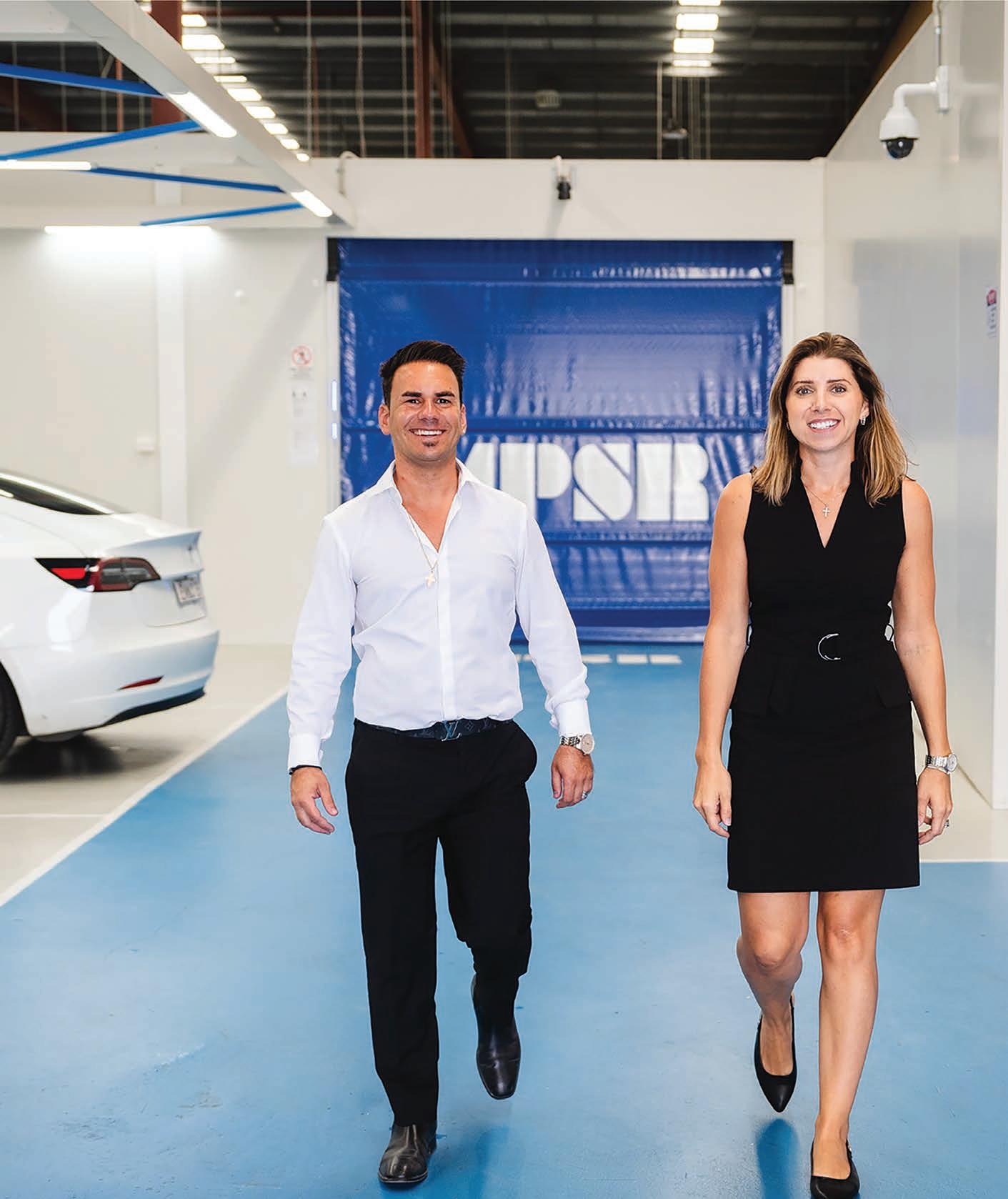
4 www.nationalcollisionrepairer.com.au Editorial
To receive our weekly e-newsletter sign up at www.nationalcollisionrepairer.com.au



The RAPTOR evolution is here
Since its introduction into the automotive scene, Raptor products from U-pol have developed an industry reputation for ultra-durability across a surprising diversity of applications and temperature resistance.
Introducing the RAPTOR High Temperature range, six new RAPTOR products formulated to perform in temperatures from 120°C to 1000°C. 5 times tougher than ordinary paints*, RAPTOR High Temperature products provide superior protection from heat, impact, and corrosion. Easy to use, fast drying, and with an attractive smooth finish. There’s a RAPTOR High Temperature product for almost any job.
Professional quality RAPTOR Wheel Paint is ideal for extending the life of worn or damaged wheels, supplying protection from impact, heat, stone chips, brake dust, and corrosion. It’s chemically resistant to oils and tra c film. Suitable for use on all types of primed metal wheels including steel, aluminium, and alloys. Available in gloss and satin black. For roll bars, chassis, or any vehicle
surface that needs extra protection, there’s RAPTOR Roll Bar & Chassis. Available in gloss or satin black. Heat resistant up to 120°C. Self-priming with exceptional adhesion, it can be applied directly to most prepared metal without primer.
Heat resistant up to 300°C, RAPTOR Engine Enamel is perfect for engine blocks, engine accessories, and other surfaces in the engine compartment. Available in Primer Grey, Bright Red, Gloss, Satin and Flat Black and Gloss Clear. Containing ceramic resins that provide superior protection from heat, oil, and other automotive fluids. Suitable for all type of primed metals.
RAPTOR Caliper Enamel contains ceramic resins that resist temperatures up to 500°C. Provides brake calipers with superior protection from impact,
heat, brake dust, automotive fluids, and corrosion. Available in Satin Black and Real Red.
For protection against extremely high heat there’s RAPTOR Flameproof. Formulated with advanced ceramic technology and high heat-resistant pigments, RAPTOR Flameproof can withstand temperatures up to 1000°C. Ideal for use on exhaust manifolds, headers, exhaust systems and other areas that require protection from very high heat as well as oil and other automotive fluids. Suitable for use on all types of primed metals including steel and alloys. Available in Primer Grey, Satin Clear, Flat Black and Flat Red.
For more information or to find a distributor of RAPTOR products go to u-pol.com/au
6 www.nationalcollisionrepairer.com.au Product Showcase
RAPTOR products can perform in a temperature range from 120°C to 1000°C.
Image: U-pol.
Reliability when you need it most
There’s nothing worse than a dead battery just when you need it most. Dependability is one of the hallmarks of Projecta equipment, whether it is in the workshop, the home or the home away from home and their INTELLI-IQ Smart Display is one more example of this innovation in automotive electronics
The Projecta INTELLI-IQ Smart Display (IQD2) makes the dreaded scenario of a flat battery at the end of the day a thing of the past. The smart display has multiple applications in professional and recreational motoring scenarios or wherever a driver wants to have full knowledge of charge rates and retain control over their 12V system IQD2 is the communication hub for the Projecta DC system, enabling users to create a smart home on wheels. It provides complete control of the DC System, including charge rate and battery voltage. IQD2 is the first of five phases of the Projecta Internet of Things (IoT)* System, and it ensures both scalability and allows the integration of future products and technologies. Projecta’s IQD2 links connected products within the Projecta ecosystem, with new ways
of connecting and controlling devices without being physically hardwired or using Bluetooth®.
Don’t get stuck in 2024
IQD2 and the IDC25X DC to DC charger are designed for the future and will seamlessly integrate with the upcoming phases of Projecta IoT. This means that as technology advances, the IQD2 and the IDC25X are prepared and ready to adapt and upgrade the smart home on wheels.
Projecta Senior Brand Manager, James Pearson, said the new INTELLIIQ Smart Display unlocked the full potential of the IDC25X DC to DC charger and other Projecta equipment.
“When paired with the IDC25X charger, the INTELLI-IQ Smart Display further elevates the charger by o ering total and convenient control – in combination, the technology is unique and industry-leading for the segment,” Pearson says.
“Many competitor systems feature Bluetooth® control where the appliance connects directly to the smart device. These systems can be subject to functionality issues with range and connectivity; this is often because the
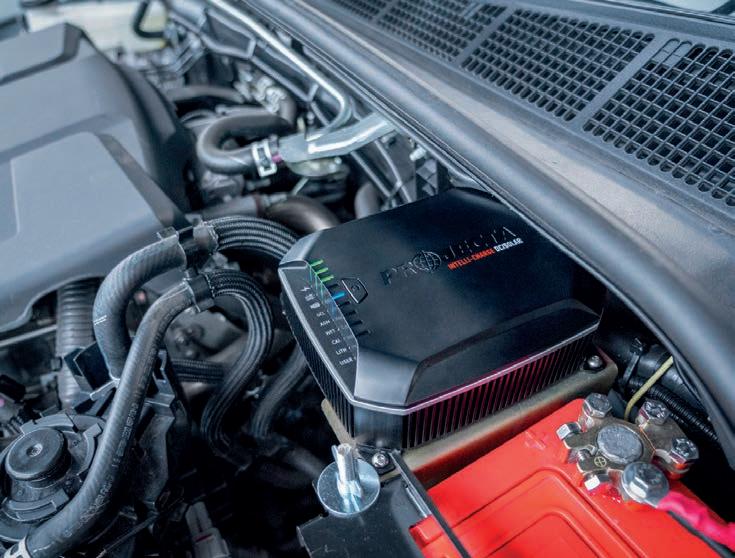
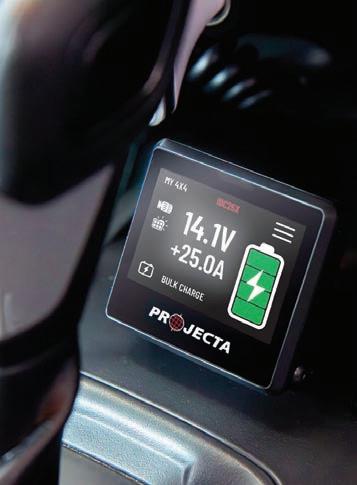
appliance is mounted in the engine bay or another area shielded by layers of metal, causing a barrier for the Bluetooth® signal. In comparison, the IQD2 o ers automotive grade communication meaning no dropouts along with an easy set-up,” he said.
The IQD2 takes the award-winning DC DC charger IDC25X to the next level and allows for both scalability and implementation of future products and technologies. The IDC25X can charge any battery chemistry that is currently on the market, but with the IQD2 and the INTELLI-IQ App, defined profile settings can be changed and allow for not yet invented battery chemistries to be charged. This also allows scalability when the user needs additional power.
Mount it anywhere
The INTELLI-IQ Smart Display unit features a 2” display screen. It can be mounted anywhere the user deems suitable due to its single-wire connectivity, and the cable is easy to manipulate around a vehicle or a caravan. Owners can also extend, shorten or even run their wire through a trailer plug. The unit itself can be mounted flush, at an angle, or even upside down.
Further information go to www.projecta.com.au
The National Collision Repairer 7
Projecta have brought their innovation and dependability to an even wider range of applications.
Images: Projecta.
Images: Projecta.
The display can be mounted almost anywhere.
Product Showcase
Handling the future safely
Recent figures show almost one quarter of new vehicles are made up of hybrids and EVs and it is only a matter of time before their presence is felt on the repair shop floor.
The question for many collision repair businesses is how to get ready to and how to ensure any workplace can deal with them safely.
Safe Working on Electric and Hybrid Vehicles
Unquestionably there are new and inherent risks associated with the maintenance and repair of Electric Vehicles and Hybrid vehicles in contrast to conventional vehicles such as:
• Short circuits creating explosions and fires
• Exposed connections and the presence of high voltage cable which has the potential for electric shock, resulting in serious death or injury
• Components that may retain a dangerous voltage even when a vehicle is switched o
• Harmful gases and liquids released when batteries are damaged
• Vehicles silently moving and people not aware
• Components that may move unexpectedly due to magnetic forces
Obtaining additional skills, appropriate training through registered training facilities and following the car manufacturer’s guidelines will be necessary to allow technicians to work safely with these vehicles.
Having a proper procedure to depower and reinitialise battery electric vehicles, incorporating a lockout procedure so the vehicle can’t be re-energised until technicians have completed their tasks is also essential for safe work practices.
Going in equipped
But there is also the indispensable gear

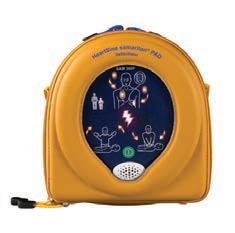
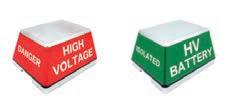
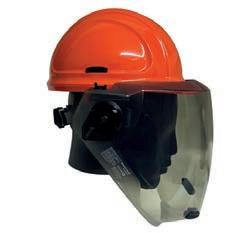

a workshop needs to tackle EVs and hybrids safely.
AS 5732:2022 “Electric Vehicle Operations- Maintenance and Repair” lists necessary personal protective equipment (PPE) depending on the task and level of risk involved.
Some of these last line of defence measures include:
Electrical Insulating Gloves with an appropriate voltage rating, commonly these are Class 0, that o er protection up to a working voltage of 1000V AC /15000V DC. These can be worn with a cotton under glove to reduce sweating and provide comfort. Leather overgloves are worn to protect the rubber insulated gloves from mechanical harm and also to provide protection against electrical arcing.
The use of Caution signage and

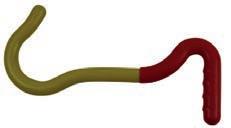
Warning steering wheel covers to alert others of potential risks and temporary exclusion zones to instruct non authorised people to keep away.
Using 1000V insulated rated tools when working on energised components to lessen the risk of shorting out the high energy source.
Wearing arc rated face shields and clothing to protect the face and body against the direct force of an electric arc incident.
Having an (AED) automated external defibrillator immediately available in the event of an electrical shock.
To get more information on product solutions that help technicians mitigate risk when electric and hybrids are worked on contact Electrical Factory Outlet. www.electricalfactory.com
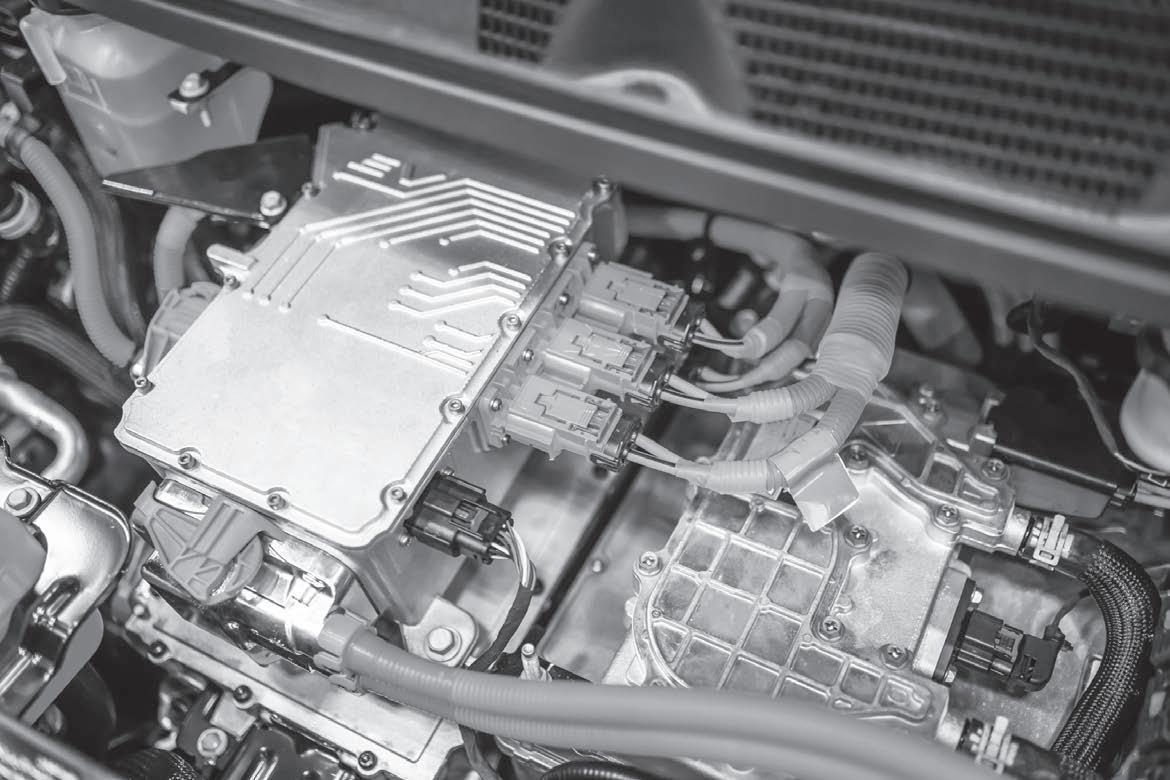

8 www.nationalcollisionrepairer.com.au
High-quality equipment that ensures the safety of workers in the modern EV workshop.
EFO has everything needed for technicians to safely work on EVs.
Images: EFO.
Developing specialised products
As the rapidly developing electric car market evolves, EFO is continually searching for creative yet workable solutions that are simple to implement in mechanical workshops.
One of the elements that makes Electrical Factory Outlet stand out from many suppliers is their commitment to innovation and maintaining an edge over competitors.
They do this by developing products that solve problems or provide improved work practices for any technicians working in automotive electronics. They work with utility companies, electricians, and their supply partners, to design products to comply with Australian Standards and meet the demands of the specific tasks the customer wants.
Electrical Factory Outlet collaborates

Factory
with RTO’s, Industry Associations and TAFE Colleges across Australia that provide training for electric and hybrid vehicles. EFO provides product solutions that help keep workers safe when repairing and maintaining these vehicles.
The products are used and reviewed by qualified and operating electricians to ensure they meet the triple criteria of being safe, the highest quality and great value for money. The company also backs up its products by ensuring they are supported across Australia. Decades of accumulated knowledge in the industry, an agile approach to meeting any issue or problem are some of the other hallmarks of their service and advice.
EFO is a prominent supplier of high-grade 1000V rated Tools, Safety
Products, and Test Equipment. Providing a complete line of personal protective equipment, including covers, mats, and insulated gloves rated for a working voltage of 1000V AC/1500V DC. In addition, exclusion zone barrier kits, rescue crooks, automatic external defibrillators, caution signage, arc-rated clothes and face shields.
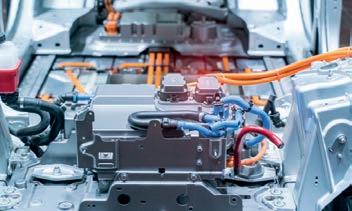
Electric & Hybrid Vehicle Safety Trolley
The trolley contains the basic safety equipment and signage requirements of AS 5732:2022 “Electric Vehicle Operations Maintenance and Repair.” Designed to be portable with locking wheels the trolley can be moved to any bay the EV or Hybrid vehicle is being worked on. The technician’s personal protective equipment, emergency equipment and tooling will always be near the potential risk area.
Part No. EVSTROLLEY
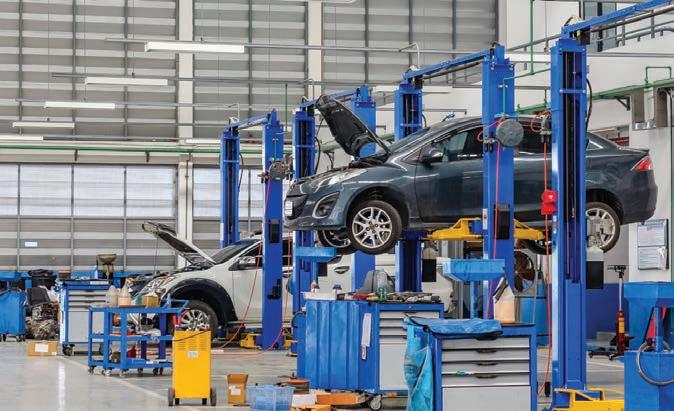



Ph: 07 3209 4333 E: sales@electricalfactory.com.au www.electricalfactory.com.au



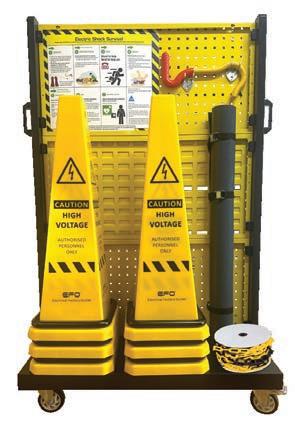
Electrical Factory Outlet Pty Ltd
For further information contact Electrical Factory Outlet www.electricalfactory.com.au Electrical
Outlet
Image: xioalange/ stockadobe.com.
More EVs mean workshops need to be equipped to work safely.
The art of reliability
If there is one quality repairers cherish in the workshop, it is dependability. And when it comes to getting cars started, there is one product name workshops love to rely on: Projecta.
With vehicles frequently sitting idle in the workshop for some time, often with varying degrees of battery life and quality, jump starting is a part of everyday life for mechanics and repairers. This is why they turn to equipment they trust. The name of Projecta is one that is repeatedly raised by technicians for the equipment’s features, safety and ability to get things moving time after time. The National Collision Repairer magazine spoke to several workshops about what they are like to work with.
Trusted
For Josh Jones owner and manager of Quick Spark Automotive his view of Projecta Intelli-Start range of jump starters all comes down to one word: “Quality”.
His successful Sunbury business services a wide range of clients in the growing area on the outskirts of Melbourne and he cannot speak highly enough of the quality and dependability of their equipment and how it keeps his business moving.

“If you bring a car in and leave the ignition on for example, you’re doing a service and it’s sitting there for a couple of hours and the battery goes flat; you bring the Projecta in and it will jump start it every time.
“If something comes in with a faulty alternator or dead battery or on the back of a truck, we can go out, jump start it and bring it into the workshop.”
The Rapid Charge technology in Projecta units means they can recharge themsleves if left connected to a vehicle. The Intelli-Start Jump Starter can fully replenish the energy that was discharged during the starting process in just 40 seconds.
Jones sees the application for the starters as potentially even more crucial for collision repair shops, to avoid time wasted over flat batteries and ensure workshop e ciency.
“Sometimes they have cars sitting around for ages. This IS3000 should be a best seller for panel shops, who would be able to jumpstart anything.”
Mechanic Martin Lanza at Revesby Motors, another busy automotive repair shop based in western Sydney, highlights the wide range of cars that can need jump starting from depleted batteries.
“Modern cars are never really o , there are a number of circuits consuming electricity, the remote keyless entry system for example,” Lanza says
“Sometimes after major mechanical work a car is reluctant to start, the battery can quickly become depleted and a jump starter is required. With older cars, often collectors’ showroom items, the battery goes flat through age, these also need to be jump started.
“Cars that break down and are not repaired quickly often flatten the battery or cars being sent to us on a tow truck

Cover Story 10 www.nationalcollisionrepairer.com.au
For Quick Spark Automotive owner Josh Jones and his team, the Projecta IS jump starter range o ers dependability for years of operation.
Image: Prime Creative Media.


also often need to be jump started.”
In all these scenarios it is the dependability of the Projecta IntelliStart range that stands out for Revesby Motors.
“We’ve been using the IS1500 for 18 months and IS2000 for 6 months. Both the IS1500 and IS2000 have excellent performance in all three start-up scenarios,” Lanza says
“We use the IS1500 on a wide range of vehicles from small cars to large vans. The case construction is rugged and has survived a number of accidental falls. The IS2000 is a new addition to the workshop. It’s very impressive, more powerful and has more features.”
“Prior to these we used a large battery on a trolley. Portability was poor and the operator had to be very careful as the jumper leads were always live.”
Jones agrees it is hard to look back at old systems once a workshop has come to rely on Projecta Intelli-Start jump starters.
“The worst thing about the old set ups was they were huge, and you had to drag them around on wheels, and if you had anything outside it was a pain but with the Projecta you just grab it, carry it out and get the vehicle started.”
The compact nature of the units is enhanced by their portability, with shock proof casing, comfortable carry handles and modest weights for even the most powerful units, 10.6kg and 13.5kg for the IS3000 and IS5000. Jones is impressed by the versatility of the larger units, especially with the larger IS2000, 3000
and 5000 range that have the flexibility to do 24V charges.
“We’ve had a IS1500 for four or five years and it has been brilliant,” Jones says.
“But this IS3000 is the next level; the big one. This is probably a good all round workshop unit because it has the capability of starting anything; trucks and cars and look how small it is, you put this in your little car, run out and you can jump start anybody.”
Jones says this dependability and flexibility adds to workshop e ciency and in turn saves time and money. He says he uses it for a couple of jump starts a day in his workshop after which the unit goes back into its convenient desktop 5V cradle to recharge and is always on hand, fully charged when needed.
“But with the Projecta you wouldn’t have to recharge this for ages, you probably get ten starts out of it.”
“The Rapid Charge technology is beneficial, on busy days where we can jump start multiple vehicles multiple times,” Lanza says.
“Without Rapid Charge we may have had to put some jobs to one side and wait for an overnight charging operation. We really appreciate the smart charge feature, after starting a car the IS2000 will recharge o the car’s alternator. This is an excellent feature because it ensures the jump pack is always in a high state of charge. On a busy day with multiple jump starts this avoids the jump pack becoming discharged and unusable before charging.”
Safety First
“The safety features provide total peace of mind for both the operator and the business owner,” Lanza says.
“Batteries have high energy levels and mistakes can harm people, vehicles and equipment. Factoring out these risks carries a lot of weight with us.”
For Jones at Quick Spark Automotive the simplicity of the units and their intuitive controls makes them largely mistake proof, a valuable safeguard for the safety of sta and vehicles.
“With the old school jump starters, if you jump started something backwards you could blow the main fuse, or the alternator or even the computer. The Projecta units have a safety feature, if you put the clamps on backward it won’t power,” Jones says.
Jones also cautions mechanics and repairers about relying on many other modern jump starters that lack the

The National Collision Repairer 11
The team at Revesby Motors rely regularly on Projecta jump starters to get all kinds of vehicles running.
The IS3000 Intelli-Start comes in a sturdy and portable carry case.
Image: Projecta.
Image: Projecta.
power and dependability of Projecta units, particularly some cheap units sold to motorists.
“Those little ones, you’ve got to connect them up then let them power up because they have capacitors inside and then it gives you one big bang and that’s it. But if the vehicle doesn’t start, you’re screwed because you only have the one charge.”
By contrast both workshops agree the investment in Projecta jump starters is an investment in long term dependability.
“The cheap ones, they just don’t last but with the Projecta, it has been at least four years and I don’t know how many starts. Over the years I have sold I don’t know how many. When people learn about Projecta, they just want these units.”
Lanza agrees, “The IS1500 model has been our “go to” jump starter for the last 18 months. It’s compact, powerful and very easy to use. Our business depends on these devices.”
Features
A further benefit of the latest models is their ability to jump start vehicles and machines that use a variety of battery types including Lithium, Wet, AGM, Gel and Calcium.
The Intelli-Start range is equipped with premium LiFePO4 batteries, the safest lithium technology available. The range also utilises an advanced all-inone protection system that prevents surges, short circuits and overheating. The display will also alert the user of an incorrect connection and advise when they’re ready to use.
Common to units are premium sparkfree clamps, ‘no solder’, high current connections for added longevity and performance, intuitive LCD display with real time updates, in-built LED work light, EVA storage case, USB charging port and the ability to be used as a powerbank.
Projecta’s jump starters also provide more starts with up to 2000 battery cycles – around four times more than competitor Lithium Cobalt based jump starters. This range delivers a substantially longer operating life and provides a smooth
and reliable start, time after time.
Added durability comes from the range’s rubber moulded impact and drop resistant housing and IP-rated dust and water ingress protection.
The top of the range; IS3000 and IS5000 jump starters are ideal for use on large industrial and commercial equipment including heavy-duty trucks, tractors, and agricultural equipment.
The IS3000 is suitable for both 12V and 24V electrical systems and provides 1000A clamp power for 12V systems and 850A for 24V electrical set-ups, along with 3000 peak amps – it’s enough to start petrol and diesel engines up to 12L displacement in 12V machines and all 24V engines.
The IS2000 model is a compact model providing even further versatility, with its auto sensing clamp connections making it convenient for use on both 12V and 24V electrical systems. The
IS2000 will jump start 12V petrol vehicles with engines up to 8.0L and up to 6.0L for diesels. It can also jump start 24V vehicles – both petrol and diesel –with engines up to 7.0L.
The IS1400 is suitable for 12V electrical systems and o ers 500A clamp power and 1400 peak amps, more than enough to start petrol-powered vehicles up to 7.0L displacement and diesel engines as large as 5.0L. These capabilities along with a compact design makes the IS1400 an ideal choice to carry in the glovebox, for stowage with 4x4 recovery gear, or to keep on hand at workshops or car yards.
Other Projecta Intelli-Start models in the existing line-up include the IS920, IS1220 and IS1500.
For more information go to projecta.com.au

12 www.nationalcollisionrepairer.com.au
Story
Cover
Josh Jones, Daniel Penny and James Carr speak highly of the Projecta starters they have used for years.
Image: Prime Creative Media.
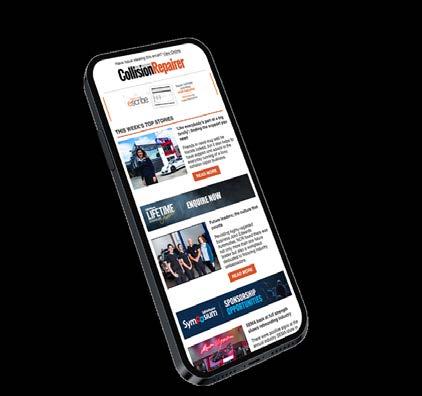

www.nationalcollisionrepairer.com.au Promoting businesses, growing the industry Reaching more than 2500 recipients across the industry, our weekly newsletter is also a great opportunity to promote your company. For advertising details contact kerri.mccauley@primecreative.com.au National Collision Repairer Our weekly newsletter delivers the latest news, views and product information direct to your inbox. STAY UP TO DATE WITH THE LATEST INDUSTRY NEWS
Expo breaks records for ‘incredible industry’
Australia’s biggest aftermarket expo has lived up to its name, breaking records in attendance over the three-day event and opening the door to many future opportunities for the repair industry.

The combined Australian Auto Aftermarket & Collision Repair Expo saw 13,282 visitors pass through the Melbourne Convention & Exhibition Centre in April.
Australian Automotive Aftermarket Association CEO Stuart Charity described the biennial event as a resounding success with the range of training, innovations and product o ers giving visitors the incentive “to charge into the future” with new skills, ideas and opportunities.
“I am incredibly excited about the success of the 2024 Auto Aftermarket Expo and Collision Repair Expo. The vibe was electric in the packed halls, and feedback from visitors has been o the charts. The number and quality of exhibitors was amazing, as was the popularity of our expanded training programs and features. Expo ’24 was a truly remarkable and extremely valuable trade event,” Charity says.
The Expo was o cially opened on Thursday 11th April by Dr Andrew
Leigh MP, Federal Assistant Minister for Competition, Charities and Treasury and was joined by Stuart CharityAAAA CEO, Wayne Bryant – AAAA Board Chairman, Bill Hanvey – CEO Auto Care Association (USA) and Gino Ricciuti – APMEC Chairman. With over 400 exhibitors representing the entire automotive aftermarket supply chain, attendees were treated to a showcase of the latest tools, technology, parts, and services.
14 www.nationalcollisionrepairer.com.au
Repair
2024
Collision
Expo
More than 400 exhibitors packed the exhibition centre.
Image: AAAA
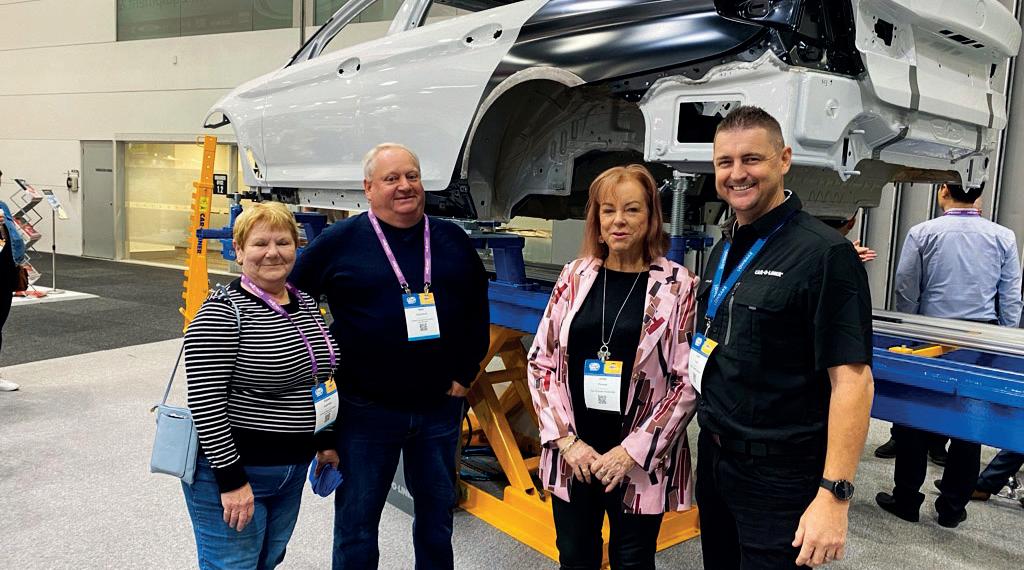
“Our objective was to show visitors how incredible our industry is and give them access to new skills, products, equipment, experts, o ers and opportunities - all under one roof,” Charity says.
“The tradeshow floor encompassed renowned brands, sought-after training, and avenues for career and business advancement. This is a fundamental role of the AAAA, and we are very proud of our contribution to fostering industry growth through this event. The Expo has exceeded expectations across all our key measurables and the feedback we have received has been overwhelmingly positive,” Charity says.
The Expo Electrified Zone and ADAS Technology Zones proved to be valuable additions to the Expo. With all scheduled training sessions for each zone fully booked ahead of the event, it demonstrated the hunger the industry has for these emerging and critical

areas of the automotive aftermarket.
Training was a central feature of the 2024 Expo, with the delivery of comprehensive training sessions covering advanced diagnostics, EV training, business management and collision repair.
The Business Education Program covered the most important automotive business topics, led by many of Australia’s leading aftermarket voices and respected subject matter experts, as well as Auto Care Association USA President and CEO, Bill Hanvey. Subjects covered the latest aftermarket trends, how to address the industry skills shortage, marketing and much more, with many sessions filled to capacity.
The international flavour of the Expo continued in an exclusive Collision Repair Training Program. US based EV expert Dirk Fuchs, CEO of Electric Mobility Consulting held multiple
sessions covering EV service, repair and workshop fundamentals.
“I want to sincerely thank all of our incredible exhibitors, our world-class speakers who came from across the globe and around Australia, and the record number of visitors who showed their commitment to the future of our industry by taking time out of their businesses to attend - the passion and dedication shown by everyone involved has been brilliant,” Charity said.
“I’d like to acknowledge and express my gratitude for the support of Auto Aftermarket Expo Major Sponsor Repco, and Collision Repair Expo Major Sponsor SAPE Group, and all of our valued partners and sponsors who helped us to deliver this amazing industry event.
The next Australian Auto Aftermarket Expo and Collision Repair Expo will take place in 2026.
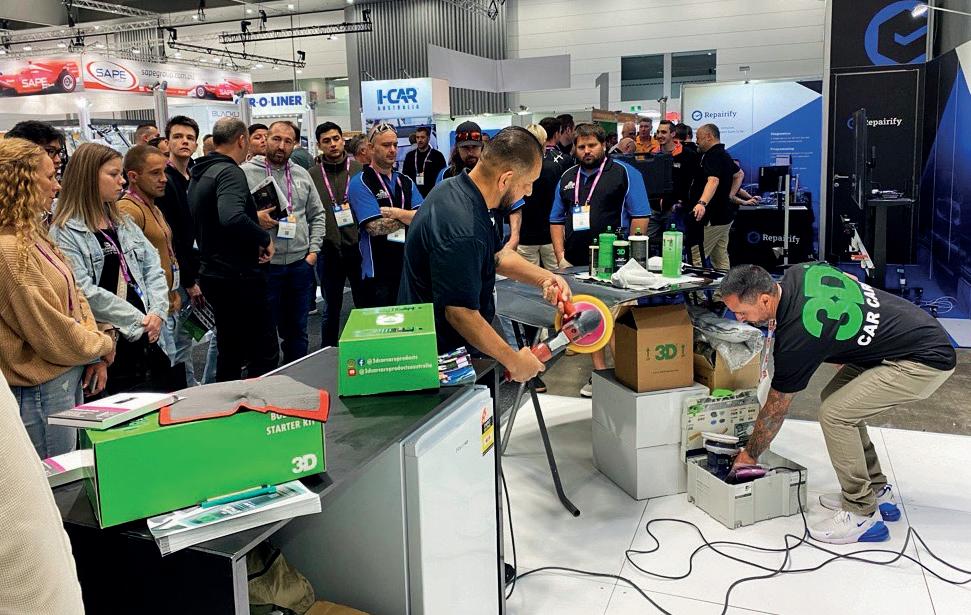
The National Collision Repairer 15
Major suppliers like Car-O-Liner are a big part of the Collision Repair Expo.
Images:
Prime Creative Media.
Demonstration crowds were often three to four deep.
On floor demonstrations were an ongoing attraction.
Collision Repair Expo 2024
Insights from a global industry leader
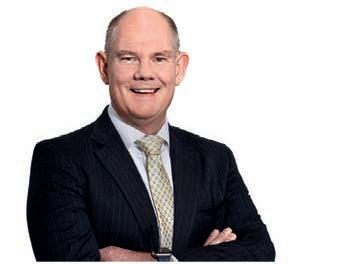
This year’s Collision Repair Expo had a special guest from ‘across the pond’.
Bill Hanvey, the President and CEO of Auto Care Association (ACA) USA made his way to Australia to speak at the Melbourne Convention and Exhibition Centre.
Hanvey represents the entire supply chain of the independent automotive aftermarket in the United States.
With a jam packed schedule, Hanvey presented on panels across three
seminars, including the Right to Repair, Global Automotive Aftermarket Trends and Skills Shortages.
NCR sat down with Hanvey at the Expo to gain further insight into Hanvey’s extensive knowledge in the automotive aftermarket.
“I feel very honoured to be brought here to talk about the United States and pass on our knowledge,” Hanvey says.
Hanvey is a strong advocate for unifying the industry through solid communication and collaborative work.
“The key thing that we can learn together, whether you are in Australia, or in the States, or New Zealand, is that our industry’s similarities are much more aligned than our dissimilarities.
“And that we can work collectively on the issues that face our industry is more productive.”
With over 35 years in the automotive industry, Hanvey broke down three keys pillars in pushing the sector to the next level.

“The key pillars are identifying good talent to work in the industry, elevating the image of the industry, and thirdly, understanding the issues that are in play on both sides of the pond,” Hanvey says.
“The main message from me, is that if we collaborate and work on these issues together it is much more e ective.”
Identifying good talent also means finding good talent to support the industry. Hanvey, the ACA, and the AAAA are focussed on lifting the image of automotive careers, one that is not just about ‘getting your hands dirty’.
The high-tech industry is something to be celebrated, however, public perception still needs improvement.
“Unfortunately, the perception of the industry has not changed as quickly as the technology has in the industry. That is something that the AAAA is working on in Australia, and Auto Care in the United States is also working on.”
“It is really important to communicate to young men and women when making career choices how technologically advanced the industry is.”
“Education is a crucial mechanism to ensure our industry is sustainable and continues to grow.”
Hanvey outlined how Australia’s industry di ers from the United States, with diversity being a key di erence.
“Australia has a much more diverse vehicle population than the United States. There are a lot of di erent players. New Zealand also has tremendous diversity in their vehicles in operation. So yes, I think that the Australian automotive industry is an agile one.”
Despite the di erences in the aftermarket and legislation, Hanvey is dedicated to collaborating with Australia and New Zealand in growing the capacity of the automotive industry.
“We can all learn from each other.”
16 www.nationalcollisionrepairer.com.au
Bill Hanvey, President and CEO of Auto Care Association USA.
Images: AAAA.
Lectures proved a vital part of the Collision Repair Expo whether they were on business insights or technical subjects like ADAS.
What to do: skills shortages
The skills shortages is a complex issue that requires a unified approach, according to industry leaders. The Collision Repair Expo gathered four experts to talk about while there may be no easy, quick solution, there are key strategies that workshops can implement to find and retain sta .
The panel gave pragmatic advice on the proven tactics to find new team members and keep them engaged in your business. The panel included Lesley Yates from the AAAA as MC, Bill Hanvey from the Auto Care Association USA, Adam Pay from MyCar Tyre and Auto, and Fred Molloy from Konnecting Group.
Bill Hanvey - Auto Care Association USA
Hanvey outlined the work that is being done in the United States, and how there is a push for more to be done in encouraging young people to enter the automotive career pathway.
“We are working with members of Congress to promote apprentice programs. We also do it on the state level. We are far behind in terms of where we are in terms of the apprenticeship programme. But it is near and dear to our heart, and we are really trying to promote that in the US,” Hanvey says.
Relationships and connections with schools and university are key strategies to broaden the potential for gaining workers in the industry.
“Make it a point to establish a relationship with technical schools and high school programs so you are aware of one another. This will make it easier to recognise talent at an earlier stage,” Hanvey says.
Adam Pay - MyCar
Pay highlights the multifaceted issue of keeping sta and of recruiting new people.
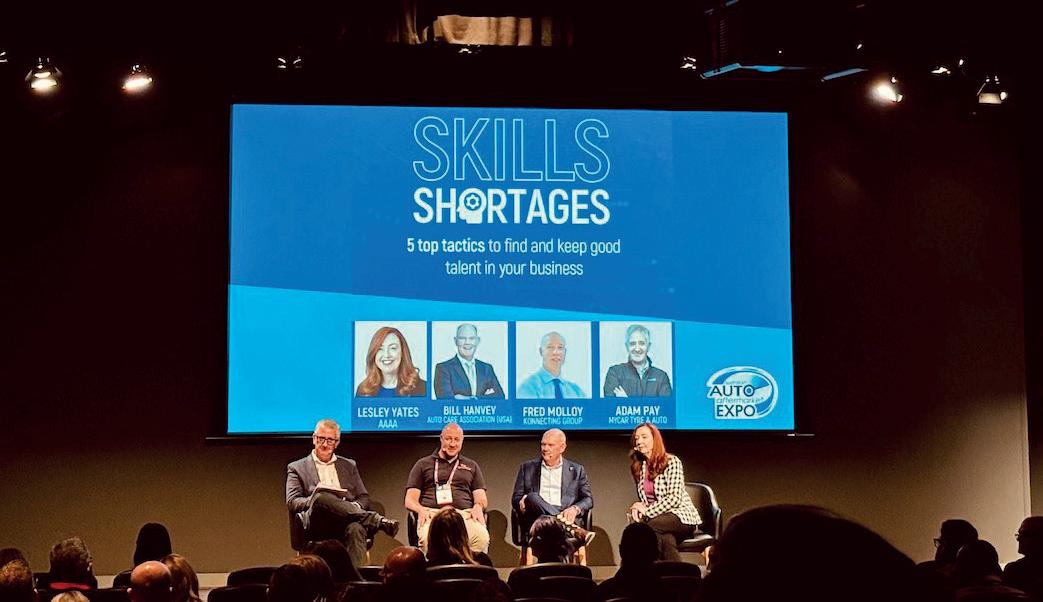
“A few years ago, we decided to measure retention instead of turnover. So instead of asking why people leave, we are asking why people stay. Measures for success are a key focus for us,” Pay says.
“At My Car, we have a retention goal of 85 per cent. At the moment, it is at 75 per cent, so there is still work to be done.”
Pay emphasises the importance of shifting your focus onto the environment of your workshops.
“Where you apply your focus, is where you have the best result,” Pay says.
“We have 460 apprentices right now, which is a good number. However, we do still lose too many first years. I think we have a solid apprenticeship programme.”
Changing with the times is also essential for keeping up to date with the latest technologies, and the retention of sta .
“As the world is changing, it is a good opportunity to rethink and reimagine what the apprenticeship program could look like.”
“Gone are the days where you advertise on Seek. You have to start way further down the chain now. We have had some really good success with partnering with schools. It is so easy to do. You are pushing on an open door.”
“It doesn’t matter if you are a MyCar with 280 stores or an independent operator with one store, schools greet you with open arms,” Pay says.
“We aim to attract, develop and retain the very best team and when you get them, to support them, encourage them, and keep them engaged.”
Fred Molloy Konnecting Group
The demand for labourers is at an alltime high. Registered migration agent from Konnecting Group, Fred Molloy emphasised the need for not only gaining and retaining sta in the industry but foreseeing issues and planning ahead.
“The amount of calls I get from workshops saying can we get any technicians, can we get any panel beaters, or can we get any spray painters. The skilled migration piece is part of the proposal. It is normally the last desperate resort,” Molloy says.
Molloy stated that forward planning is essential in seeking international workers.
“Workshop owners need to be strategic. Getting skilled labour from overseas is a process that takes anywhere between 3 – 12 months. It can be done, but you need to get your ducks in a row.”
The National Collision Repairer 17
Image: Prime Creative Media.
The Skills Shortages panel on stage.
A ‘Right to Repair” score card

The Right to Repair: Fair and Open Competition – Are We There Yet? Seminar was held at the Collision Repair Expo 2024 as part of the Business Education programme.
The seminar was led by Lesley Yates as MC from the AAAA, Bill Hanvey from the Auto Care Association (USA), and Stuart Charity from the AAAA.
Stuart Charity outlined the history of the Right to Repair movement in Australia, the highlights of the law so
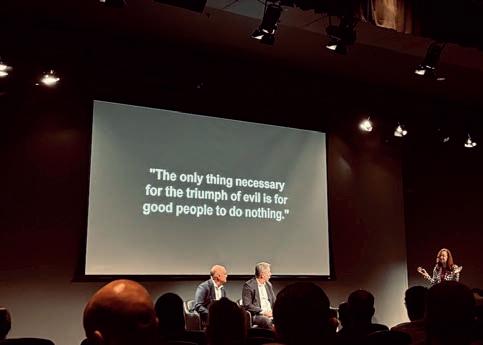
far, and areas that need improvement.
In Australia, the Right to Repair became enshrined in law in 2022 after a decade-long campaign. Despite this, there are still multiple hurdles in car owners’ way when repairing their cars, including missing information and the navigation of OEM websites.
Charity gave the audience a ‘Score Card’ on the Right to Repair law so far.
“There wasn’t a major issue with right to repair in the industry in 2009, but we knew it was coming because we have international linkages. There was already a lot of activity overseas at that time,” Charity says.
“We also knew it was going to take a long time to get a law in place. We got the ball rolling very early.
“The campaign got the Government to take on the recommendations of the ACCC. This engagement, grass roots campaign got everyone involved, from workshops to both sides of Parliament on board.
“By the time the legislation was
introduced into Parliament in 2021, it changed our competition laws.”
Charity’s Right to Repair Score Card
The green ticks:
• Functioning sustainable AASRA
• Dedicated enforcement: ACCC Motor Vehicle Information Scheme (MVIS) unit
• Registered technicians/data is flowing.
• Complaint and referral process
• Dispute resolution.
• Learning and continuous improvement
Areas for improvement:
• Untested legislation with no precedent
• No visible enforcement action to date
• Separation of EV from non-EV.
• EV training requirements
• Scan tools and third party data providers
• Low awareness
• Telematics is not included.
“The right to repair law is principle based. It means that any independent repairer operating in our market can access full dealer information. However, the law isn’t too descriptive on how that information is delivered,” Charity says.
“This is a blessing and a curse. It is blessing that there is flexibility in changing the scheme to suit the market conditions if it is not working. The curse, however, is that there is a lot of grey area in the legislation and a lot of that will have to be tested by precedent.”
“AASRA is up and running and doing a fantastic job.”

18 www.nationalcollisionrepairer.com.au Collision Repair Expo 2024
The ground floor of the Expo.
Bill Hanvey’s presentation on the ACA’s Right to Repair initiative.
Images: Prime Creative Media.



FOR ENQUIRIES: (02) 9772 9013 OR VIEW THE IRT RANGE ONLINE AT SAPEGROUP.COM.AU CONNECT, FOLLOW AND HAVE A CONVERSATION WITH US 3-2 PCD CURING SMALL SIZE REPAIRS & PRIMERS 4-2 PCD IR CURING HIGH OUTPUT IR MOBILE DRYER IRT 1 PREPCURE HANDHELD DRYER WITH 1 LAMP IRT 2 PREPCURE HANDHELD DRYER WITH 2 LAMPS IRT UV SMARTCURE BATTERY POWERED UV CURING IRT UV SPOTCURE POWERFUL HANDHELD UV CURING IRT SINGLE RAIL SYSTEM RAIL MOUNTED IR CURING ADAPTED FOR THE PREP AREA IRT POWERCURE ARCH INSTALLED IN A SPRAY BOOTH TO GREATLY SHORTEN CURING TIMES IRT I-CURE ROBOTIC DRYER ROBOTIC IR AND UV CURING FOR THE SPRAY BOOTH AND PREP ZONE SAVE
WITH A WIDE SELECTION OF INNOVATIVE HIGH-QUALITY, USERFRIENDLY, SPACE-SAVING SHORT-WAVE INFRARED (IR) AND ULTRAVIOLET (UV-A) IRT DRYERS - AVAILABLE EXCLUSIVELY THROUGH THE SAPE GROUP!
SPACE, TIME AND MONEY
Collision Repair Expo 2024
The world on show
Exhibiting at the Collision Repair Expo is a major investment in time and resources, but the returns come in the form of high exposure to eager businesses and the opportunity to showcase the best that automotive innovation has on o er.
Long a fixture at the Collision Repair Expo, the SAPE Group is not only a major exhibitor but again took up the key role of principle sponsor to the show.
The massive SAPE Group stand, strategically placed near the entrance to the Collision Repair Expo, was one of the highlights of the diverse event and the biggest they have mounted yet.
The SAPE Group aimed to showcase the best on o er in collision repair and drew experts from around the globe to showcase a range of cutting-edge equipment and materials.
SAPE Group CEO Paul McMartin says the diverse o ering of innovative products showcased SAPE’s unwavering dedication to excellence within the industry.
McMartin said the multiple presentations and sections, all with easy access and experts on hand, allowed visitors to the SAPE stand to celebrate innovation and excellence in the industry.
The Weilander + Schill Workbay WS Arena Plus was just one of the show pieces of the stand. Integrated
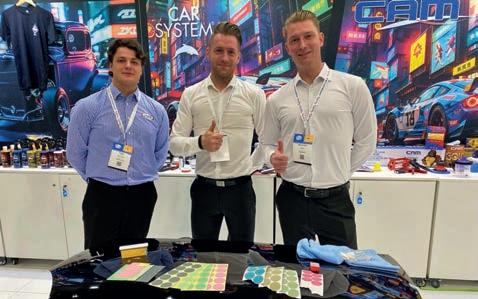

with other key equipment, it o ered the potential for increased bodyshop e ciency including with the increased demands of new automotive materials, such as working with aluminium and carbon fibre.
The system comes equipped with protective spark curtains and special daylight lighting that meets the industry requirement of 1000 lumens at one metre height.
Weilander + Schill product manager Stefan Knappe said the flexibility it adds to a workshop gives it the capacity to work with aluminium in a multipurpose booth without having to build a dedicated space solely for a new material, often impractical in an existing business or any location where space is at a premium., But critically it allows the workshop to do that work safely with key preventative equipment for any ignitions.
“The special extractor unit means they can work on aluminium, clean the
space and then work of steel without any danger of ignition that can come from working with both materials,” Knappe says. “The unit also has a special spark filter that ensures the safety of the workspace.”
These safety requirements are now mandated by a range of European OEMs potentially giving the wellequipped workshop the capacity to work on a range of cars including VW, Audi’s and Porsche.
SAPE Group’s Tony Maher who has more than 30 years’ experience in the industry, said the cutting-edge equipment meant a business could meet the increasing sophistication of the industry.
“This investment unlocks so much potential in the workshop,” Maher said.
Elsewhere, sophisticated coatings solutions where on display at the consumables stand, including a delegation from German company Vosschemie showing o Carsystem
20 www.nationalcollisionrepairer.com.au
Pepijn Woerdman, Maximillian Voss and Steven Luck demonstrated the beautiful finishes of Carsystem.
Images: Prime Creative Media.
Nick McDonald, Adrian Albany, Lachlan McMartin, Tony Maher, Joakim Gorsberg and Stefan Knappe show o a Spanesi bench in the Weilander + Schill Workbay.
with live demonstrations of repairs.
“My father met Ray McMartin (Father of SAPE Group Director Paul McMartin) more than forty years ago and the partnership is still going strong,” Vosschemie head of automotive Maximilian Voss says.
“They were both family businesses, so it was a very good fit.”
Another partnership for SAPE group on display was HB BODY, leading supplier of coatings and automotive repair solutions in Europe and across the world.
The company, originally founded in Thessaloniki, Greece had its paint mixing technology on display and along with a range of top-level coatings.
Consistency is one of the major strengths of the technology, o ering dependability for the workshop, HB Body’s Christos Demertzis explained.
“One of the most important things is ensuring batch consistency,” Demertzis says.
“Imagine if you are dealing with 90 pigments and only one of them is slightly o , the result can be a disaster.”
This is why experts at HB BODY and other suppliers for the SAPE Group want to ensure they are providing the highest quality and services to equip the modern repair workshop. Other highlights of the stand included renowned brands such as Spanesi, Celette, Gys, Jollift, Irt, Kamatec, Drester, Scangrip, and Carbon Plus along with consumables stand like Juice, Por-15, Sika, Roar, Cam and Scangrip.
For more information go to www.sape.com.au




THE ULTIMATE PH NEUTRAL CLEANER THAT IS HIGHLY EFFECTIVE IN REMOVING BRAKE DUST AND FALLOUT FROM WHEELS.
IT HAS A DEEP CLEANING ACTION THAT EFFECTIVELY REMOVES DIRT LEAVING A BRIGHT FINISH.
PLASMA DOES NOT MARK CERAMIC BRAKES, CHROME, GALVANISED METAL, ALUMINIUM OR POLISHED ALLOY.
AVAILABLE IN 500ML, 5L aND 20L.
The full team were on hand to help visitors at the massive SAPE group stand. Image: SAPE Group
Experts were always on hand at the SAPE group stand to demonstrate the benefits of investing in great equipment.
Christos Dermetzis and George Kazepis from HB BODY are proud of their cutting-edge products.
JUICEPOLISHES.COM.AU
Lifetime Achievement Awards
Celebrating the best
The National Collision Repairer Lifetime Achievement Awards kicked o a special week in Melbourne with the gala event celebrated on the eve of the 2024 Collision Repair Expo.

About two hundred industry leaders, innovators, suppliers, services and supporters gathered to recognise outstanding achievements in the repair industry on a night designed for fun and networking opportunities.
The evening was hosted by AFL legend and media personality Dermott Brereton, who revealed his talents extended even further, having run a panel beating business himself in Melbourne for several decades.
Brereton, or “Dermie’ as he is a ectionately known, regaled the room with stories from that era in the industry, including some amusing mishaps with fellow Hawthorn legend Robert “Dipper” DiPierdomenico.
But after the fun and banter, the order of the night lay with its key purpose; to recognise and celebrate the role models in the collision repair industry.
The Lifetime Achievement awards, which began in 2007, were created to acknowledge the dedication and commitment of the men and women who have contributed to the collision repair industry over and above their “day job”.
The criteria for induction are a minimum of 20 years in the collision repair industry, with contributions to the industry beyond the scope of their local area and their direct employment.
The gathering represented a who’s who of the repair industry, including sponsors, collision repairers, suppliers, insurers, and previous inductees who gathered to celebrate the people that make the industry strong, innovative and supportive.
National Collision Repairer magazine editor Eugene Du y says the awards were a vital part in how the industry rewards success.
“For almost two decades this award has been a great tradition for the best in the industry and with many great winners over the years,” he said.
“These are the first awards since NCR magazine’s acquisition by Prime Creative Media and in many ways, we are the custodians of this great tradition. Prime Creative Media’s values align well with the collision repair sector because it is dedicated to showing the best in that industry and to help it grow. That is why we wanted to ensure it was a gala event that becomes a red-letter day in the repairers’ calendar.”
In 2024, the Lifetime Achievement Awards also reflect the changing nature of the industry and have incorporated two new awards, one for women in repair and one for future leaders.
In 2024 The Lifetime Achievement Award, proudly supported by Platinum sponsor Repairify, celebrated an individual who has made significant contributions to, and achievements in, the collision repair industry over the course of their entire career. The award recognises an individual who have demonstrated excellence, innovation, and a lasting impact in the industry.
The new Women in Automotive award, proudly sponsored by PPG, is an important new inclusion and gives recognition to women in repair businesses alongside the prestigious accolade for lifetime achievement.
The Next Generation Leader award, sponsored by Capricorn, was also celebrated on this special night and showcased the valuable contributions made by up-and-coming achievers in the industry.


22 www.nationalcollisionrepairer.com.au
LA Award winner Craig Carey celebrates with family and friends.
Sarah Karavasilias enjoys the evening and her award with her husband Johnny, also a nominee on the night.
Images: nicrobertsmedia.
Next Generation Leader winner Nick Batey with supporters.
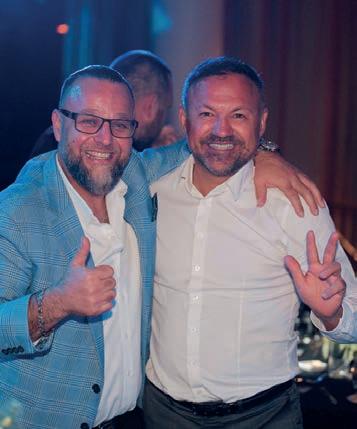

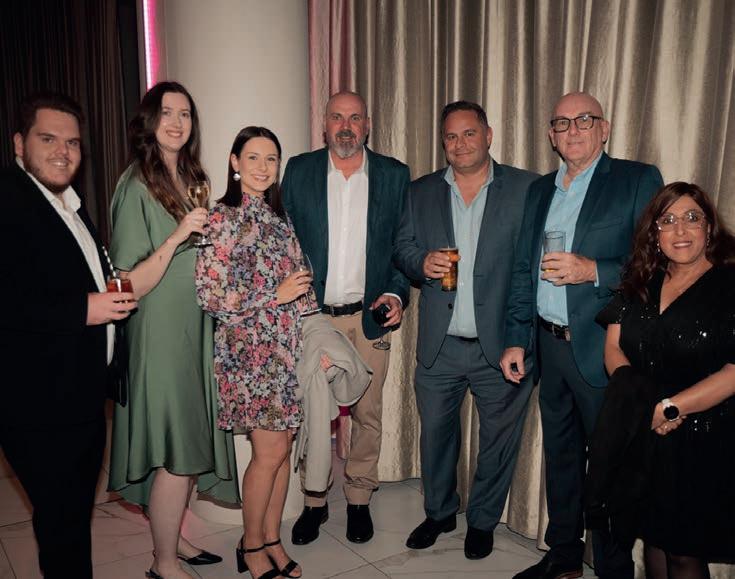



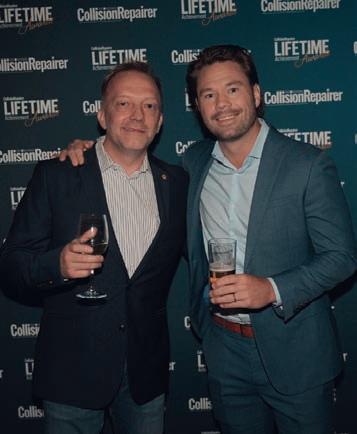
The National Collision Repairer 23
The gala awards night was a who’s who of people in the repair industry ranging from suppliers like SAPE Group, PPG, BASF, Saint Gobain, Car-O-liner, industry services like Repairify and Capricorn to a whole range of repair workshops from Car Craft, Sheen Group, Fix Auto, the AMA Group, Western General Bodyworks Group, MPSR Group, Walker Crash Repairs and Carllision Group to name a few.
Images: nicroberts_media.
Lifetime Achievement Awards
Support when you need it
The 2024 Lifetime Achievement Awards would not have been possible without the generous support of its sponsors and leading the group was diagnostic specialist Repairify Australia, platinum sponsor of the evening.
Repairify Australia General Manager Tristan Sender says he was thrilled to a be a platinum sponsor of the 2024 Lifetime Achievement Awards.
“The collision industry wouldn’t be the innovative, cutting-edge industry it is today without the people in it,” Tristan told the industry gathering at the gala night in Melbourne.
“We’re proud to support the prestigious Lifetime Achievement Award and celebrate the outstanding work and meaningful impact of long-serving industry experts.”
“In my opinion, the collision repair industry doesn’t get all of the recognition it deserves. It’s an essential part of our economy and in so many ways, it’s what keeps our nation moving. Nights like these that recognise leaders in the industry that have dedicated their lives to it are so important.”
But Tristan also said beyond the great nominees and worthy winners the awards were also about celebrating the wider industry and its future.
“Creating a culture of recognition and holding up examples of people who

have had successful careers is essential to encouraging people of future generations toward joining us,” he said.
“Collision Repair is going through a period of change in terms of technology as it develops and becomes an increasingly important part of the repair process. Whilst change can be challenging and create new and rewarding careers and jobs for people entering our industry, the changes in technology will also provide new opportunities for savvy repair businesses to generate new revenue streams.”
“Repairify is new to the Australian market but has been helping the collision and aftermarket repair businesses navigate these changes in technology and profit from them. We are a large employer in America, Mexico, UK and in Europe and we intend in the future to provide many people with long and rewarding careers within the broader repair industry.”
Repairify is driven by the fundamental industry objective; to get damaged cars back on the road, safely and e ciently.
Since launching with their cuttingedge diagnostic tools in Australia late in 2023, Repairify has seen a rapid uptake of their services as technology increases in vehicles and automotive repair shops turn to experts to unravel the complexity or overcome secure gateways.
Repairify o ers a diagnostic tool, a tablet-based device known as the “Allin-One” which enables the workshop to complete local diagnostics, performed at the car side by a technician from the workshop. But critically when gateways or new technology prevent the technician from going further, Repairify’s services allow them to undertake remote diagnostics with the help of their experts.
Without this access workshops may be faced with repair jobs that require extra expense and can inflate the repair time such as having to transport the vehicle for calibration or wait for a time it can be booked in at a third party or dealer.
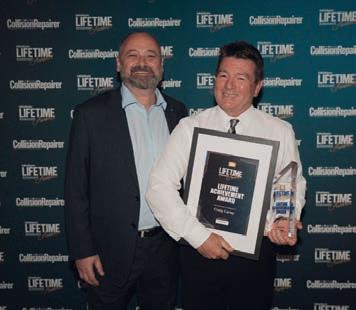
Repairify’s Remote Services allow the technician to plug into the vehicle, access coding, calibrating and diagnosing the car using the Original Equipment Manufacturer’s tool and Repairify’s qualified technicians giving workshops a crucial time advantage.
The benefits for the workshop to have this added flexibility are many, including workshop revenue as it allows them to retain the allowances insurers have for calibration.
“The beauty of it is that you don’t need to take it to a dealership to have that job done,” Tristan told NCR. “There are two major advantages. The first is speed. Key to key time is massively sped up because you basically do it there and then in your workshop. The second is you also keep that revenue directly inside your shop because you can complete the whole job from start to finish. Importantly, by being able to access secure gateways using our OEM tools you can keep jobs in house that you would previously have been unable to complete.”
He says the whole industry benefits, from the satisfied customer to the insurance company that is covering the cost.
“It’s a win-win situation for the insurance company, body shop and customer. The time that the car is o the road is lower, which is good for customer service and customer retention and time saved results in reduced repair costs.”

24 www.nationalcollisionrepairer.com.au
Repairify can help in finding diagnostic solutions with their highly experienced team. Image: Repairify.
Repairify Australia GM Tristan Sender congratulates award winner Craig Carey on the night.
Image: nicrobertsmedia.


Proudly Sponsored by:
The National Collision Repairer magazine would like to thank its generous sponsors of the 2024 Lifetime Achievement Awards.
Platinum Sponsor

GoldSponsors

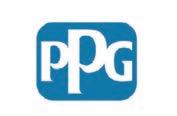
Evening Sponsors










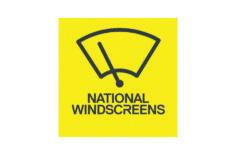
Lifetime Achievement Awards 26 www.nationalcollisionrepairer.com.au
Fostering success
Self-e
acing and down-to-earth, the long career in collision repair of Craig Carey is anything but ordinary and sets a model in the industry for dedication and growth.

Former AMA Group leader and industry veteran Craig Carey is the latest inductee in the prestigious National Collision Repairer 2024 Lifetime Achievement Award.
The Lifetime Achievement Award, sponsored by Repairify, is one of the industry’s most prestigious awards and celebrates those involved in the sector for more than 20 years who have made outstanding contributions to the wider industry.
With more than forty years in the industry before his retirement in 2023, Craig Carey is a well-known collision industry leader who has forged a strong legacy in Tasmania and across the repair sector.
Over these decades, Craig has shown a commitment to the industry, to developing the next generation of leaders and tradespeople and a passion for quality and achieving OEM accreditation.
In the judges’ comments they noted Craig’s long commitment to the industry and his professionalism.
“Craig’s Carey’s career is marked by a series of strategic advancements and leadership roles that have significantly contributed to the industry’s evolution. Craig’s journey exemplifies dedication, innovation, and excellence. His leadership
skills are evident through his ability to mentor, guide and inspire his team. He has fostered a culture of success and growth within his organisations.
His ability to navigate through changes with foresight and adaptability underscores his exceptional capacity as a leader as a leader in the industry. Craig stands as a beacon of professional integrity and visionary leadership, making him a distinguished leader in the collision repair sector and an absolutely worthy recipient of this year’s Lifetime Achievement.”
More than two hundred peers and leaders from across the industry cheered the 2024 winner at a special gala night at South Wharf in Melbourne in April.
“It’s really humbling to be recognised by your peers after such a long time and when there are so many of them in the room,” Craig Carey said.
“I’ve made some lifelong friends both in the panel beating and paint industry and the insurance industry and there are some super close friends in the room.”
But Craig saved his especial thanks for his wife, Deanne of 39 years, who he said had been a great support during the highs and lows of his long career.
Craig has championed many initiatives
and changes across his career spanning 40 years. In his roles prior to retirement, he drove improvements and initiatives across the business. This included a review of the Capital SMART business as well as driving operational and profitability improvements in (what is now) AMA Collision.
Darren Wales, EGM of Heavy Motor Division AMA Group says in his submission: “In the time I have known Craig and working with him within the AMA Group, he has led various successful initiatives within the AMA Group and Capital SMART. He has implemented and managed multiple projects that have enabled change within the business. He has provided a “handson” mentoring role to his team and is respected by those around him.”
The Centre Manager at Craig’s original Micra Repair Centre in Breadalbane, Josiah Casboult says that “even when he wasn’t running the site, he always knew what was going on at site level and industry level. He always knows the question and the answer before I’ve asked it. He is really switched on.”
“I worked for Craig for 12 years. He taught me everything, from my time as an apprentice, through to being a qualified tradesman, then as an estimator.” Josiah says.
Craig is very disciplined leader, known for keeping his workshops in order and coaching others to do the same. He is a courageous leader who is not afraid to say what he thinks. Those who have worked directly with him say that nothing phases him, and he’s always taken everything in his stride.
Craig began a qualified panel beater and spray painter before starting his first collision repair business, Longford Bodyworks, with his father-in-law in 1989.
The National Collision Repairer 27
Craig Carey with his family as he enjoys the accolade of one of the repair industry’s highest awards.
Image: nicrobertsmedia.
Lifetime Achievement Awards
Young leaders shine
Young role models in the collision repair industry are critical for a future workforce and NCR ’s Next Generation Leader Award celebrates some of the best.
From six finalists to one winner, the Next Generation Leader Award was awarded at the special gala event to rising star, Nick Batey from Fix Auto Port Melbourne.
The Next Generation Leader Award was proudly sponsored by Capricorn.
The award promotes the younger generation of auto specialists rising in the ranks. It aims to recognise an individual who has impressed their colleagues and counterparts with their contribution, along with making an impact to their organisation and excellence in service.
Batey proudly accepted his award and was quick to thank the automotive industry for the opportunities it o ers.
“Firstly, I would like to say thank you to everyone here tonight. To the National Collision Repairer magazine, thank you for putting
on this lovely night,” Batey says.
“Thank you to Fix Auto for giving me the opportunity to be here in this category.”
Batey’s 10-year career in the automotive industry has taken him to di erent places. He began as a young man, doing three years of an apprenticeship and followed that with multiple jobs within the industry, including with Capital SMART, RPM Somerton and Repairhub.
“When you’re young, you always do a bit of everything. Panel shops are normally good at this and show you around and give you a taste of what all the di erent jobs are, especially at Fix Auto. They want to give you a taste of everything to learn what you are good at,” Batey told NCR.
Capricorn – Australia’s largest

automotive cooperative that has more than 29,000 members representing all forms of the automotive industry, has been a strong supporter of the NCR awards.
The Award was presented by the CEO Automotive at Capricorn, Bradley Gannon.
“Capricorn are thrilled to be a sponsor of the Lifetime Achievement Awards in 2024,” Capricorn Group CEO David Fraser said.
“This year we’re also sponsoring the Next Generation Leader Award to show our support for the up-andcomers who will drive the industry into the future.”
“These awards recognise some of the most experienced individuals in collision repair and we are proud to play a part in acknowledging the contribution they have made to the iwndustry.”
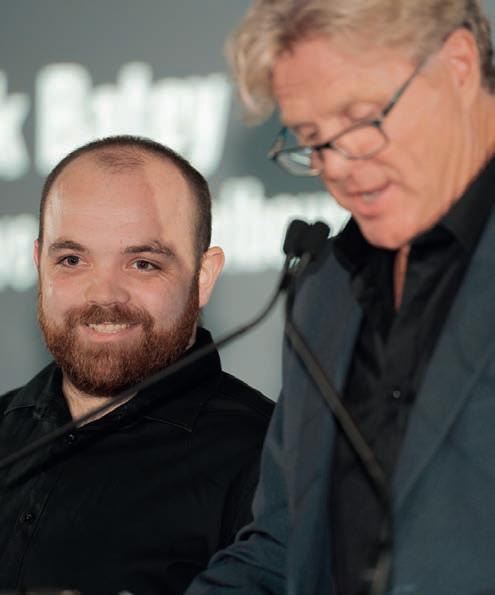
28 www.nationalcollisionrepairer.com.au
Capricorn CEO automotive Bradley Gannon Celebrates with Nick Batey. Images: nicrobertsmedia.
Fix Auto Port Melbourne’s Nick Batey took out the Next Generation leader award.

Bringing diversity to the industry
Sarah Karavasilias from MPSR Group was announced as the first ever winner for the National Collision Repairer ’s ‘Woman in Automotive’ Award. The category was proudly sponsored by PPG.

Sarah Karavasilias who holds multiple management roles at MPSR Group in Marrickville NSW brought a decade in criminal law to the family business. She highlights the industry as having good support networks which enables her to keep challenging herself and her sta .
During her acceptance speech, Karavasilias expressed her gratitude towards her husband, Johnny, who also works at the MPSR Group.
“Without Johnny I wouldn’t be able to receive this award and he enables me to be a trailblazer in the industry,” Karavasilias says.
“And of course with Johnny and the MPSR Group by my side we really want to help the automotive industry to continue and thrive.”
Karavasilias acknowledged how her prior career in law helped her navigate the auto motive industry.
“I’ve only been in the industry for a short time, starting in 2022. Previously I was doing criminal law, so a male dominated industry. It wasn’t much of a shift coming into the automotive industry.”
Karavasilias and the MPSR Group have their sights set on the future, with aims to improve the perception of the automotive industry.
“I am really focussing on trying to get the word out there to young people to get them into the industry. We have a lot to o er.”
New to 2024, the Woman in Automotive Award seeks to honour a female professional in the industry who has been a promoter of positive change.
Recipients not only showcase their own contributions to diversity and inclusion but also exemplify the skill to inspire more women to embrace opportunities in the field.
“That’s one of the benefits of being a female is that you have that sympathetic ear and you’re able to manage personal interests with business interests as well,” Karavasilias told NCR during a recent forum about life in the repair industry.
“You’ve got to have a thick skin. I always, try and challenge myself and lead by example. But we are at work more than we are at home, so you’ve also got to really enjoy it as well.”
Global coatings giant PPG is a Gold Sponsor of the awards night and a special sponsor of the category.
Presenting the Woman in Automotive Award was PPG’s Paul Galea.
“On behalf of PPG it is an honour to sponsor the Woman in Automotive Award,” Galea says.
“I first stepped into automotive industry at 15 years of age which was a long time ago. I have had the pleasure of meeting and working with many amazing women in the automotive industry. The winner and the nominee’s tonight are no exception.”
PPG Sales Director Australia with John Hristias said the awards were an important recognition of outstanding figures in the repair industry.
“Today’s robust, tech savvy collision repair industry has been made possible by people across the country who have literally put their blood, sweat and tears into it,” Hristias said.
“To help recognise that, PPG is proud to support the National Collision Repairer Lifetime Achievement Awards. As one of the longest serving suppliers to the local industry, PPG has built its success on establishing long term relationships and that has brought us into contact with individuals who have dedicated themselves to making the industry stronger. Whether these industry achievers are front and centre or operate quietly in the background, the National Collision Repairer Lifetime Achievement Awards provide a valuable way to recognise them.”
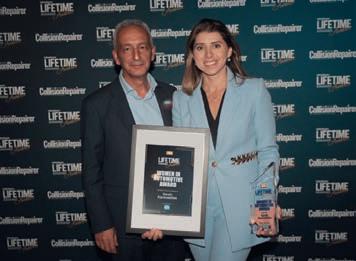
The National Collision Repairer 29
Images: nicrobertsmedia.
Sarah Karavasilias is the proud inaugural winner of the Women in Automotive award.
PPG’s Paul Galea presents Sarah with the award.
Limitless growth
Johnny and Sarah Karavasilias from the MPSR Group are shining examples of the di erent pathways that can lead you towards a successful career in the automotive industry.
With Johnny starting o as a panel and refinish technician at his family workshop, and Sarah working as a solicitor in criminal law, the unified business partners (and couple) prove there are many diverse career pathways in the automotive industry that can cater to any background.
Johnny and Sarah have ensured that the MPSR Group is a family run and centred business. This mentality also spreads to their attitude towards their employees, with a fair-go attitude at the forefront of their ethos.
Not a pair to shy away from hiring people with little experience, Johnny and Sarah’s can-do attitude embraces newcomers and apprentices with open arms. All the MPSR Group require is a willingness to work and learn.
The original repair shop that started the MPSR Group was founded by Nick
and Elias Karavasilias in 1980. It wasn’t until 2019 that Johnny Karavasilias branched out from his father and uncle’s business and opened the MPSR Group in Marrickville, New South Wales.
Johnny’s wife, Sarah Karavasilias joined him three years later in 2022, which proved to be an asset to not only the family business, but the automotive industry as a whole.
The MPSR Group is based in the heart of Sydney’s Inner West, Marrickville. The site is situated on 5,500 meters squared with the capacity to repair 150 vehicles a week.
A smart system
As an award-winning automotive repair business, the MPSR Group have the latest technology to boost not only their business, but the experiences
and opportunities for their sta .
“It’s not so easy to finish 150 cars in a week, but I always like to be on the floor and always want to improve our process and how we do things. I’m always investing in equipment, so the speed of our repairs is e cient. We’ve got two Lowbake Gas IR arches, one Lowbake Alpha spray booth and one Gas IR combination spray booth. They allow us to do between 35 to 40 cars a day,” Johnny says.
“At any given time, there is about 70 people on the workshop floor, so there is always something going on,” Johnny says.
“About a month ago we had training with the MTA for EVs. We had 10 of our sta do that course. The course was on depowering and repairing electric cars,” Sarah says.
The shift towards a streamlined
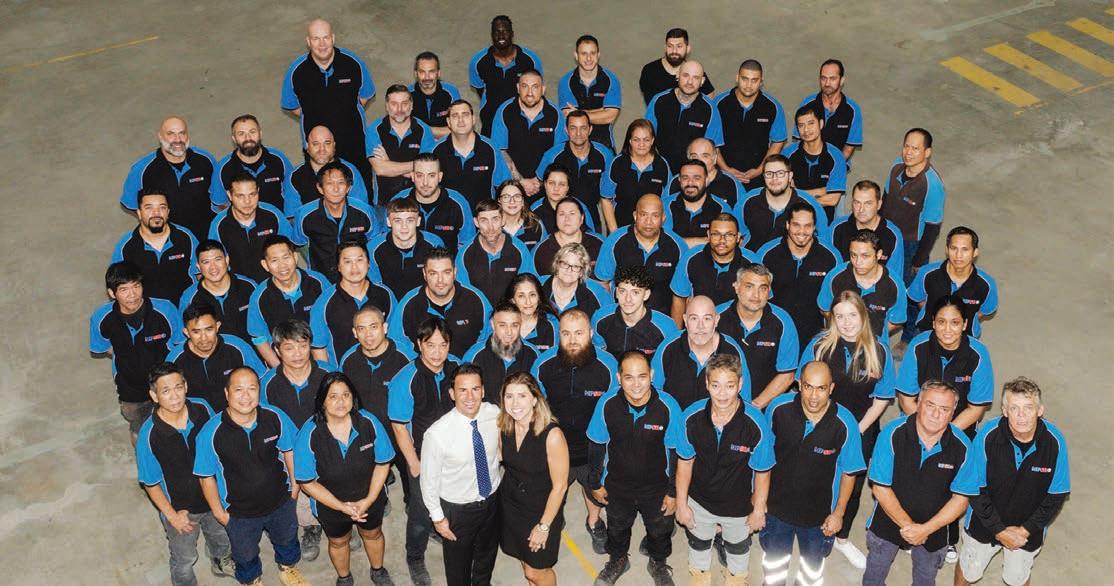
30 www.nationalcollisionrepairer.com.au
Talking Shop
Johnny and Sarah Karavasilias (front and centre) with their team.
Images: MPSR Group.

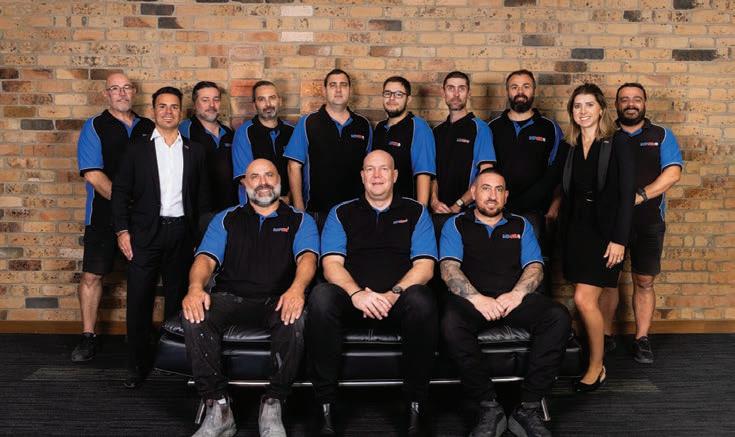
system and consistent training, was a result of the boom in business after the COVID pandemic.
“Our workload exploded coming out of COVID. In 2022 the workload just went through the roof and we were essentially catching our tail towards the end of the year. Now we’re starting to optimise what we have. We’re taking time to implement leadership training and making sure that the workshop is e cient,” Sarah says.
“We’re trying to streamline everything, so onboarding is an easy process.”
Embracing electrical
As a workshop on the path to I-CAR Gold Class, the MPSR Group is dedicated to upskilling and continuously improving their workshop and customer experience.
The Group has also invested in Lowbake equipment, which incorporates Rapid Air Drying System (R.A.D.S) that saves 80 per cent on energy costs and a 70 per cent reduction in baking time.
“About 30 of the 150 cars we repair each week are usually EVs, and that is growing every month” Johnny says.
The Karavasilias’ have made contributing to a greener future a

priority for the Group. With a Tesla accreditation received at the start of 2021, and a BYD accreditation that followed, the Group has trained sta to fix the changing car parc.
“There were little add ons when becoming Tesla accredited. There was a lot of new equipment we had to buy. Before we only had two EV chargers on site, now we have a few more to keep up with charging the customers vehicles,” Johnny says.
Risk taking and expansion
The ability to take risks has paid o for Johnny, resulting in an
The National Collision Repairer 31
Working together since 2022, Johnny and Sarah make a great team.
The MPSR Group are dedicated to upskilling their sta .
A core value at MPSR Group is giving people a fair go.
additional warehouse.
“I think one thing that sets me apart from others, is my ability to take risk. For instance, I made the commitment to invest in millions of dollars’ worth of equipment to fill out a state-of-the-art workshop without guaranteed work,” Johnny says.
“This investment, although stressful, has now brought in several contracts of insurance work and improved the overall customer experience. I work long hours to get the job done and give my other sta motivation, I love my job. I still learn new things each and every day.”
“We work well with the insurers and with the OEMs. We try our best to keep a happy medium,” Sarah says.
A fair go
Giving everyone a fair go and a chance to succeed sets the MPSR Group apart from their competition. Sarah and Johnny choose to take an informal route when looking for sta .
“I think a strength that we have is that we give everyone a go. If someone is looking for work, we call them in. I haven’t seen a CV in two years. So, I will just give them a go, give them a trial and see how they do. And then we work out if they’re going to stay on board with us. We will give everyone a chance if they want to work with us,” Sarah says.
The breadth of opportunities in the automotive industry is a topic that

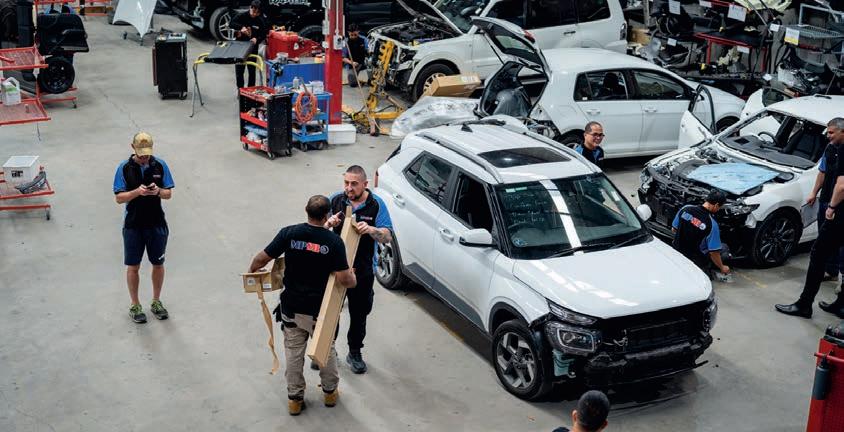
Sarah is particularly passionate about. Sarah identifies the di erent career paths within the industry as a great opportunity to get your foot in the door.
“We give everyone a go because we have so many roles in the business. From detailing to our highly trained technicians, from admin to marketing, and parts categorising as well - there is something for everyone. We have two young ladies in our parts department who categorise and receive without any prior experience. They learned how to do that on the job and they are doing very well” Sarah says.
“We’re not scared to have someone with very little experience. We’ll build them up.”
Sta retention is also a key focus for the workshop.ß They promote a community focused environment that looks after their sta with a range of inclusive measures that are designed to embrace peoples’ di erences.
“We have a lot of sta that have been with us for the whole time as well,” Sarah says.
“I’ve reached out to some local schools in the area to let them know we exist, because a lot of people don’t even know that our industry exists until they have an accident,” Sarah says.
Even though technology has rapidly evolved over the last decade, the perception of the industry hasn’t changed along with it.
“I have invited careers advisors to come on site, and their jaws are on the floor when they come to the workshop.
They don’t realise how technical it is. There is still that old stigma that it is a dirty occupation with oil all over the floor,” Sarah says.
“When people take the time to come to our workshop, they can see how hands on and high tech it is. The industry has come a long way from where it was ten, twenty years ago. That is why I have been working on finding new sta and reaching out to local schools.”
Retaining sta and making sure the working environment is community based is a key priority for the MPSR Group.
“We do a lot of sta activities. We do regular events where we go and have dinner together or we’ll go to the local pub after work. Even our Christmas parties, we had Brazilian dancers, food trucks, ice cream trucks, and the children and partners of the workers are all invited. It is a family event. We’ve also done Origin night where we’ve had big screen at the workshop. There are all sorts of activities you can do,” Sarah says.

Asking for feedback and engaging with sta is a high priority for Sarah.
“In terms of securing our sta we like to have good engagement with them, making sure they’re happy. We consult with them all the time, asking if there’s anything they think we should improve on,” Sarah says.
“We’re a family run business so we know our employees on a personal level. We like to make sure that everyone is being looked after.”
32 www.nationalcollisionrepairer.com.au
Talking Shop
Image: Nic Roberts Media.
The workshop floor, repairing 150 vehicles a week.
Sarah with Johnny, and the Woman in Automotive Award at the National Collision Repair Awards night 2024.




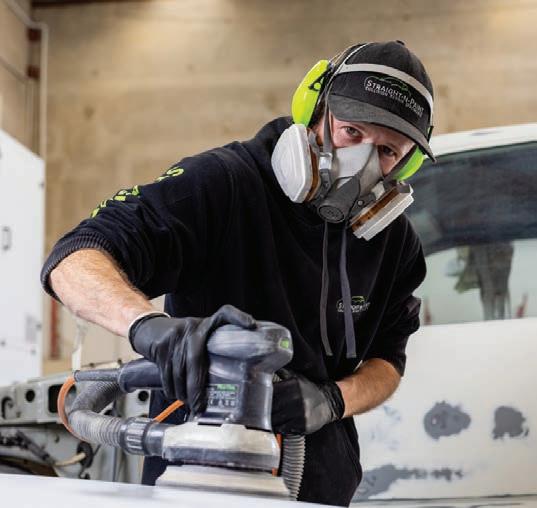








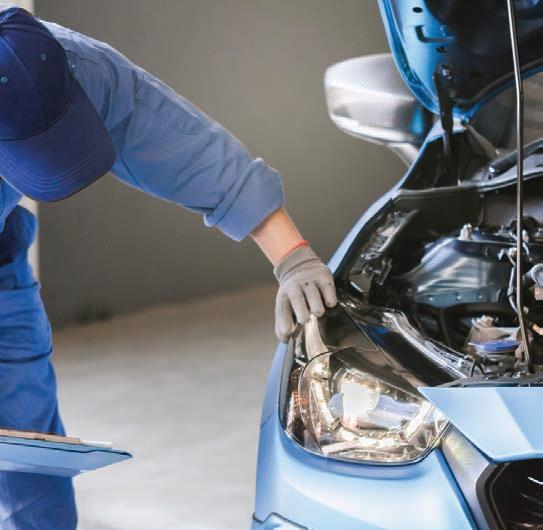
www.nationalcollisionrepairer.com.au Promoting businesses, growing the industry To make sure you don’t miss a single print edition email: subscriptions@primecreative.com.au National Collision Repairer Sign up to our weekly newsletter to receive the latest news, views and product information. SHOWCASING THE BEST IN THE COLLISION REPAIR INDUSTRY ACKNOWLEDGED BY THE INDUSTRY AS THE LEADING MAGAZINE New AMA Group chair Caroline Waldron outlines her vision Next phase for the repair industry’s code of conduct Hallam repair centre leader Daniel Wells stepping up www.nationalcollisionrepairer.com.au Capricorn Society’s State of the Nation Special Report New techniques with riveted bonding NOVEMBER 2023 www.nationalcollisionrepairer.com.au Find out more Comprehensive range of Reclaimed, Genuine, and Aftermarket parts to suit your repair needs
Finding solutions in innovation
Symposium24 is all about the future, so what could be better than having a director of innovation for a global leader in automotive technology headline The National Collision Repairer ’s forum.
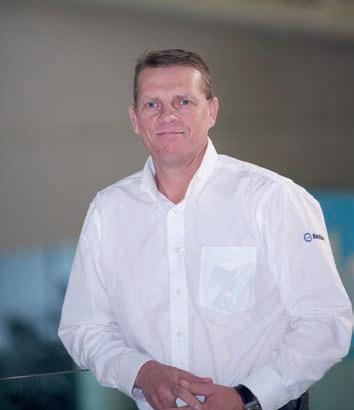
NCR is thrilled to announce that Martin Brown - Global Exececutive DirectorProduct Innovation for Repairify will be the keynote speaker at next month’s idea packed Symposium24.
Martin has a leading role as Director of Innovation for the global company that helps workshops across the world deal with diagnostic challenges.
Repairify, which launched in Australia last year, has a range of high-tech solutions for the increasing sophistication of modern vehicles including diagnostic tools that overcome gateway challenges with OEMs and add to the e ciency of any repair workshop.
The company currently diagnoses tens of thousands of vehicles each day across North America, Europe and other parts of the globe.

Martin will join a range of experts on the day, to talk about key issues facing the collision repair industry and the best ways forward.
The June symposium, hosted by the National Collision Repairer magazine, will bring together thought leaders and industry veterans to explore the challenges facing the industry, including technology, recruitment and policy that a ect the industry’s operation.
But the one-day event, titled The Collision Preparer; Fixing your future will also be firmly future focussed and help turn the changes to come into opportunities. A combination of expert panels and interactive Q&A’s will focus on the future of the repair industry. For anyone who wants to learn more and prepare for the future of the repair industry, the special one-day event will be an important opportunity to learn, discuss and take away your own solutions.
Supporting Symposium24 are some of the biggest names within the Australian automotive industry, with limited opportunities for others to join.
Repairify Australia general manager Tristan Sender says they are thrilled to be a sponsor of Symposium24.
“Events like the Symposium provide an opportunity for us to listen and learn from our colleagues in the Industry as well as talk about the innovative advancements
PROUDLY SPONSORED BY

we are making at Repairify.”
“The Symposium is shaping up to be the premier event for the collision repair industry this year, with a number of impressive speakers on the cards. It is looking like a great program, and I encourage everyone to come along”.
Australia’s largest automotive cooperative; Capricorn, its largest repair group AMA Group and leading global coatings giant PPG will all support and be featured as sponsors.
“Capricorn are proud to be a sponsor of the National Collision Repairer Symposium again in 2024,” Capricorn Group CEO David Fraser said.
“Events like these are so important as they allow people to get together, learn about the latest information and meet others working in the collision industry. “NCR always put on a really interesting and engaging event, and we’re excited to be involved.”
The event will be held at the Novotel at Sydney Olympic Park on Wednesday June 19. Tickets available for $150 (ex. GST). For more go to Symposium24 at ncrsymposium.com.au
Scan here for tickets


34 www.nationalcollisionrepairer.com.au Special Events
Martin Brown Global Executive Director for Repairify will head up an exciting day of discussions about future solutions for the repair industry.
Image: Repairify.
Turbo charge your EOFY with Capricorn finance
For tens of thousands of businesses and technicians in the automotive industry across Australia and New Zealand, the name Capricorn is not only familiar but one whose 50-year reputation has been built on trust and collaboration.
Capricorn prides itself on being a trusted, Member-based organisation that supports those in the automotive industry to build stronger businesses by saving time and money.
Capricorn Members have access to a number of services including a consolidated trade account, equipment finance, travel services and business protection.
This End of Financial Year, Capricorn Finance, available exclusively to Capricorn Members, is ready to support Members to upgrade their equipment or tools before the new financial year.
Capricorn Finance is a leading partner within the automotive industry o ering easy and convenient finance options.
Are you looking to replace dated equipment, purchase new equipment and business vehicles or support your team by upgrading their tools of trade?
With End of Financial Year specials being announced in the coming months, you can have peace of mind and confidence that Capricorn Finance is dedicated to supporting Members to access the finance they need with as little hassle as possible.
Capricorn CEO of Automotive Bradley Gannon is excited to see how Capricorn Finance supports Members this EOFY.
“Capricorn is here to support Members continue to grow and build a stronger business. Capricorn Finance understands that part of this is upgrading or purchasing equipment and vehicles to increase a workshop’s capacity and capability,” Gannon says.
Capricorn Member, Simon from Sims Auto Electrics found dealing with Capricorn Finance easy.
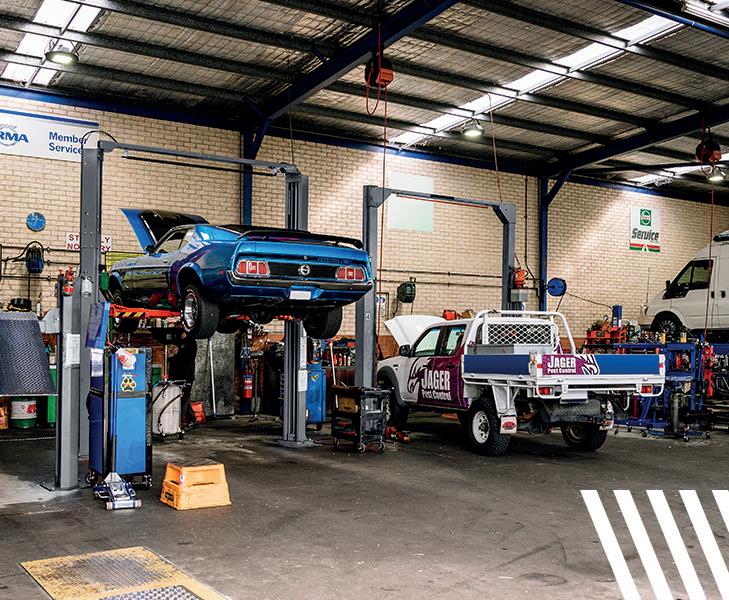
“When you are self-employed it can be very di cult to get finance but with Capricorn Finance it was smooth and easy. Capricorn Finance knows you are busy, and organising finance can often be a hassle,” Simon says.
Capricorn’s finance specialists know the industry. With Capricorn, Members enjoy industry competitive rates, zero set-up fees and the opportunity to earn Capricorn Rewards Points.
Capricorn is a member-based organisation that operates on cooperative principles.
This means Capricorn Members are also the owners of Capricorn and are eligible to receive dividends, if declared. Members also enjoy regular social and
networking events and a range of other benefits.
A successful and ever-growing organisation, Capricorn now has over 28,000 members to date, with over 2,000 Preferred Suppliers across Australia and New Zealand.
To find out more about Capricorn’s Finance, speak to their local Area Manager or Capricorn’s dedicated finance team today by calling 1800 327 437 AU or visiting cap.coop/finance.
Want to be part of the Capricorn community and to enjoy the benefits of a Capricorn Membership?
Visit capricorn.coop
The National Collision Repairer 35
Capricorn is Australia’s largest cooperative for the automotive industry.
Special Feature
Image: Capricorn.
Capricorn CEO retires
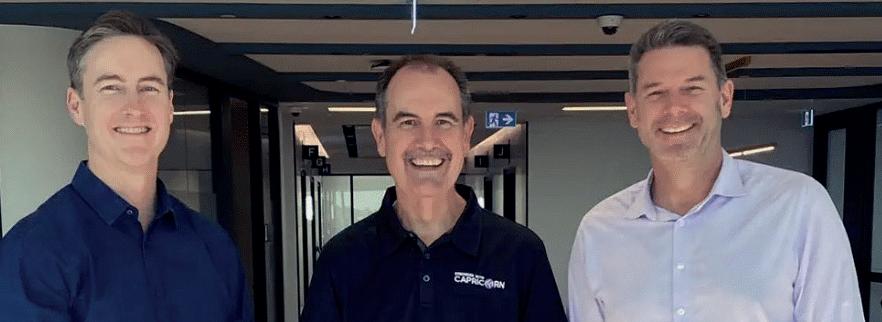
The man who has steered one of the country’s largest cooperatives, in a period of growth that has seen Capricorn grow to almost 30,000 members will retire at the end of the year.
After 18 years in the group and five as leader, Capricorn Group Chief Executive O cer, David Fraser, announced he will retire from the role, in December 2024.
The Capricorn Board has announced Brad Gannon, current Chief Executive O cer of Automotive will be the new Capricorn Group Chief Executive O cer from January 2025.
“It’s been a privilege to lead Capricorn
for the last five years, and I am very proud of what I’ve achieved and the positive impact we’ve been able to have for Members businesses,” Fraser says.
Capricorn Society Limited Board Mark Chair Cooper paid tribute to David’s contribution to Capricorn and the Industry.
“David has done a truly wonderful job of leading Capricorn over the last five years. We have seen substantial growth in this time and improved Member returns.”
“This year, Capricorn will celebrate our 50th anniversary and David has set the organisation up for a successful next 50.”
David Fraser has over 38 years of
experience in the automotive industry and has held senior sales, marketing and general management roles over the past two decades. Prior to his appointment as Capricorn’s Group CEO in 2019 he was CEO of Capricorn’s Automotive Division.
“I am absolutely thrilled that the Board have asked me to take on the role of Group CEO following David’s retirement. It is a great honour and a privilege. I look forward to continuing to deliver an amazing experience for our Capricorn Community,” Brad says.
Fraser says he is looking forward to developing his Board career further.
He currently sits on the Board of Business Council of Cooperatives and Mutuals, Western Australian Motor Industry Foundation, and Tyre Stewardship Australia.
“While there is never a perfect time to retire, I felt now is the right time for both Capricorn and for me. I have full faith that Brad will continue to grow the business to support the wonderful Capricorn community.”
Sales surge in new vehicles continues
New car sales are at their highest point in six years with EVs helping the surge and now nudging the one in ten new vehicle mark.
The FCAI’s March result shows 109,647 new vehicles were delivered surpassing the previous March record of 106,988 which was achieved in 2018.
Combined EVs and hybrids are now approaching one quarter of new vehicles sales, 23.5 per cent demonstrating the shift in buyer patterns that will eventually a ect the Australian car parc and the repair industry.
The first three months of 2024 also represent the best-ever first quarter for new vehicle sales, an increase of 13.2 per cent on the first quarter in 2023.
Battery electric vehicles made up 9.5 per cent of new vehicle sales up from 6.8 per cent in March 2023.
This is about the same as February 2024 (9.6 per cent) and up on the 2023 total of EV sales of 7.3 per cent of all new vehicles.
FCAI Chief Executive Tony Weber said that it was remarkable that nine of the past 12 months had seen the industry achieve record sales results.
“This is a terrific result for the sector however, all car brands are well aware that these results cannot be taken for granted,” Mr Weber says.
“We need to factor in the ongoing cost of living pressures and the challenges for industry and consumers that will emerge with the introduction of the New Vehicle E ciency Standard (NVES) in less than nine months.”
The SUV segment accounted for 58.9 per cent of sales while the passenger segment was down to 16.1 per cent
compared with 2023 at 17.7 per cent. The Light Commercial segment fell to 21.0 per cent from 22.6 per cent.
Hybrid and Plug-in Hybrid sales increased compared with March 2023 recording a 14.0 per cent share compared with 6.0 per cent in 2023.
Weber confirmed the FCAI position that Australia needed a fuel e ciency standard but remain concerned at the speed and magnitude of the change for manufacturers and consumers.
“The car makers will respond; however, it will take time to develop new products, especially in the large SUV and Light Commercial segments, that meet expectations in terms of price, performance and emissions,” Weber says. “Noting these vehicles make up more than one third of new vehicle sales in Australia,”
Local News 36 www.nationalcollisionrepairer.com.au
David Fraser (centre) with Brad Gannon and Mark Cooper. Image: Capricorn
The leading repair industry body aimed at tackling skills shortage has crossed o another key milestone by establishing a board of six members at its April AGM with and industry veterans joining its governing body.
The Australian Collision Industry Alliance announced all four nominations for its Board of Directors were voted in at the Annual General Meeting in Melbourne on Friday.
Sarah Moynihan, Head of People, Culture & Change at Fortress Collision Repair Services from Queensland, Mike Wilkinson, Owner/Manager at Peter Wilkinson & Co in WA, James Black, Operations Manager at Sheen Panel Service in NSW and Andrea McCarthy, Owner/Manager at McCarthy Panel Works from Queensland.
The meeting was held at the Melbourne Convention Centre while the Collision Repair Expo was wrapping up
New board for ACIA Getting the skills message across in Adelaide

another busy day downstairs.
Founding member Rob Bartlett said the board now has a valuable cross section of industry experience from some very important companies in the collision repair industry that would add to its depth, insight and accountability as a governing body.
Bartlett told NCR in 2023, establishing proper governance structures and procedures was one of the first priorities of establishing the ACIA.
In a statement, the alliance said the
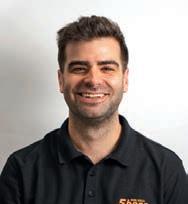

ACIA was committed to representing the needs of its members and responding to the ever-changing landscape in the Collision Repair Industry.
“The ACIA is committed to creating a diverse and inclusive board that represents its members’ interests and better serves the Collision Repair Industry,” it noted. “The ACIA will create a skills-based board aligned with its objectives to better serve the interests of its members.”
More detail, contact info@acia.com.au
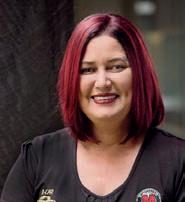
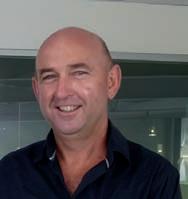
The repair industry’s new alliance, ACIA, has wrapped up another capital city visit in its endeavours to hear the issues from the front line of repair.
The Australian Collision Industry Alliance, formed last May has now completed an information tour of every state centre, aiming to generate support and discuss how the industry can work together to tackle the skills shortage in Australia. The South Australian event at the Motor Traders Association of South Australia concluded a nationwide tour of six capitals. The evenings inform the industry of the alliance’s strategy to attract new talent into the industry and to encourage businesses to join. The ACIA has 49 members to date from a cross-section of the industry.
ACIA board member Rob Bartlett outlined the aims of the not-for-profit group and how it will undertake to raise the profile of the industry with the public and to promote careers in collision repair.
“It was great to be able to share the
vision for ACIA’s national approach to tackling our skills shortage,” he says
“We’re still a young organisation with a way to go and lots to do. Together, as a collective, there is so much more we can achieve to address the biggest challenge to the sustainability of our industry.”
“I would like to thank MTA SA for hosting our information session and congratulate them on the great work they are doing with their apprentice training program.”
Dario Tonon from Eblen Crash Repairs attended the evening and joined the ACIA immediately.
“Any initiative to attract young people into the industry is welcome,” Tonon says. “As it becomes more technical it should appeal to younger people, we just have to get the message out there.”
The National Collision Repairer 37
James Black, Sarah Moynihan, Andrea McCarthy and Peter Wilkinson have joined the ACIA board.
Image:
ACIA.
Rob Bartlett welcomes Dario Tonon to the alliance.
Image: ACIA.
Tough love could lower crash rate
New research shows young drivers who share the family car are less likely to crash than those who drive their own car.
Young drivers have a 30 per cent greater risk of crashing in their first year if they drive their own car compared to those who borrow the family car, an extensive study of NSW young drivers has found.
And even seven years after getting their licences, these drivers still had a 10 per cent greater risk of crashing than the young people driving the family car, the research showed.
The multi-institutional study, published recently in the journal Accident Analysis and Prevention, included researchers from UNSW Sydney, The George Institute and the University of Western Australia. The study looked at the crash data of more than 20,000 drivers in NSW who consented to having their driving records made available via police and hospitals. The drivers were aged 17 to 24 and on their red P-plates in 2002 and 2003 and were followed up by researchers at two years and 13 years after getting their licences.
Study co-author professor Rebecca Ivers says if there was one key learning from the study for concerned parents, it’s “don’t buy your kids a car and give them unlimited access to it”.
“The first 12 months after licensing

is the most dangerous time for young drivers, and having unlimited access to a car in this period can increase their risk of crash,” Ivers says.
But for young drivers who do their driving in the family car, it’s a di erent story. Their access to the family car is restricted and they may have a parent or guardian making rules about what is acceptable driving practice, such as no long-distance driving, no having more than one other passenger in the car, or no driving at night.
“In high-income countries like Australia, there’s a culture that says you get your own car, you’re out on the road and you’re free and independent,” Ivers says.
“Unfortunately, at this age, with limited
experience on the road, it’s a very dangerous time for young drivers... And then there seems to be something about owning their own car and having greater access that might mean they drive di erently than if they were driving the family car.”
Ivers highlights another factor that may come into play is that cars given to young teens and young adults may not be as robust as the family car.
“What often happens is that people buy a cheap car for their kid, and so the kid’s driving around in a clapped-out older car with fewer safety features. So, the advice here is, let your kids drive your car, let them negotiate the use of it, and make sure they’re driving the safest car that they possibly can.”
Rewards for safer driving test
Insurance company, AAMI, has announced a new research project to test if financial rewards for younger drivers in NSW encourage safer driving behaviour, reducing accidents and injuries.
In a first for the insurance company, the project, funded by the NSW Compulsory Third Party insurance regulator, will test the driving skills of up to 500 young drivers by using the telematics feature, AAMI Driver Rewards in the AAMI app to see if their driving behaviour can be influenced by financial incentives
Suncorp Group’s CEO commercial and personal injury Michael Miller said the research will be focused on young drivers, because they are most at risk on our roads.
“Younger drivers are at higher risk of having more accidents than older drivers and because of that, in New South Wales, they pay significantly more for their CTP Insurance,” Miller says.
“We have to keep trialling new technology to see what works. Anything that has the potential to improve driving
behaviour and reduce road accidents is worth trying. Fewer accidents, means fewer injuries and that means lower CTP premiums.”
Miller said recruitment to take part would start in the next few months.
“Once the driver enables permissions through the AAMI app, the app will automatically track the user’s driving without them touching it for six months and score them on key behaviours like speeding, acceleration, cornering, braking and phone use.”
38 www.nationalcollisionrepairer.com.au Local News
Image: Africa/stock.adobe.com.
The test shows behaviours change when younger drivers are in the family car.
New plans for windscreen giant
Australia’s largest independent automotive windscreen company, National Windscreens, has announced a major investment and new management to help shape its future.
Boutique private equity firm, Nash Capital has acquired a majority stake in the Melbourne based company with previous owner, Eric Heine remaining on the board of directors and a shareholder.
The acquisition will see highly credentialled industry figure, Campbell Jones join National Windscreens as Group CEO with immediate e ect whilst all key management have been retained.
“This is truly an exciting time for National Windscreens, our customers and sta ,” Jones says. “The result of Nash Capital becoming a majority shareholder will be a significant investment in our people, facilities, equipment and the expansion of our network through company owned branches.”
“The auto glass sector represents
one of the best growth opportunities in the automotive industry with specialised technology like ADAS (Advanced Driver Assistance System) at the forefront of the potential. We are planning on elevating National Windscreen’s capability in not only this area but in our overall service o ering and branch footprint,” Jones says.
Current CEO, Brad Jansons will move
into the key role of executive general manager - Auto Glass.
“Brad has been instrumental in our success over the past 6 years and will focus on improving our auto glass business throughout Australia with the Nash [Capital] investment, he is armed to provide our teams with improved tools, training and a number of strategies to grow our business.”
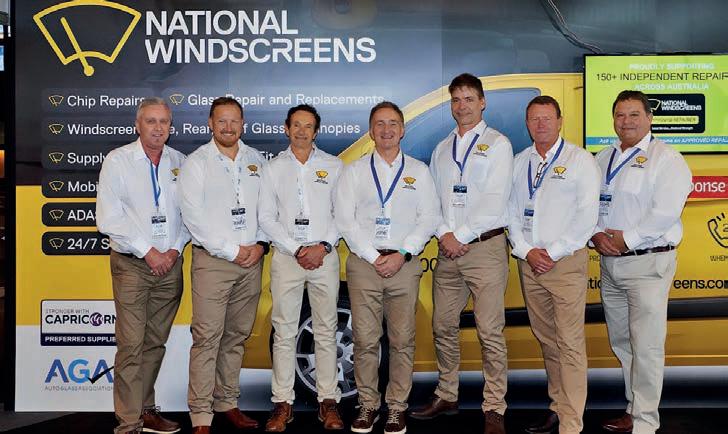
Faid joins AMA Group
The former head of Fix Auto in Australia and the Asia Pacific Stuart Faid has taken up a key role at the AMA Group.
Faid will begin next week as the Executive General Manager – Specialist Businesses at AMA Group, Monday 15th April 2024.
Faid left the Fix Auto Group this year after overseeing the expansion of its franchises and was replaced by Scott Croaker at the global company as its Australian head and has also had a prominent role as a founding member of the Australian Collision Industry Alliance Faid has been a passionate advocate of the automotive industry for more than 30 years, an AMA Group release noted.
“After starting his career with the Volkswagen Group in the United Kingdom, his experience has spanned
working in and with collision repair, retail, dealerships, Original Equipment Manufacturers, and service providers.
Faid’s career in the automotive industry has seen him living and working across multiple geographies, including Europe, Asia, the Middle East, and Australia. Stuart has also worked with businesses including MSX International and Daimler Group.
“As the Executive General Manager – Specialist Businesses, Stuart will be responsible for the newly formed Specialist Businesses unit. This business unit will include AMA Group’s Advanced Driver Assistance Systems (ADAS) calibration business, TechRight, as well as TrackRight, the Group’s mechanical business and AMA Prestige collision repair.

“Faid will also be responsible for developing new, ancillary business operations, technical training, and Marketing.”
AMA Group Chief Executive O cer, Mathew Cooper,who himself only took up the top role after the departure of Carl Bizon at the AGM late in 2023, has welcomed Faid to the Group.
The National Collision Repairer 39
Image:
The Nash Capital investment will mean new people and expansion for National Windscreens.
National Windscreens
Image: AMA Group
Stuart Faid will head a special business unit.

Australians are open to self-driving cars but want to keep control
New research has revealed Australians are open to the future of self-driving cars but want to retain ultimate control.
The Swinburne University of Technology research found in a group of 562 respondents that the support for selfdriving technology was good with almost half in favour of it as an option but three quarters wanted to retain the option of human driver intervention.
The academics Hussein Dia and Ali Matin found in their survey of 562 respondents from Melbourne, the overall results showed 47 per cent of respondents had a positive view of autonomous vehicles as a desirable trend and travel option for Australians. 18 per cent disagreed and 35 per cent were undecided.
About 47 per cent said vehicle automation would reduce their driving workload. A majority (51 per cent) believed automated vehicles will provide them with more time to complete other tasks while travelling. The study also showed there was good support for the potential of these vehicles to improve safety and reduce vehicle emissions if they are electrified.
However, respondents did not favour a level of vehicle autonomy that do not require any human intervention. A large number, 74 per cent felt vehicles must have the option of being driven by a person. Giving complete driving responsibility to a computer would make 62 per cent of respondents feel stressed. Around 70 per cent said they would like
to control where and when to use the automated functions. More than half (55 per cent) thought it was unsafe for children to travel without an adult in a self-driving car.
Around 80 per cent of respondents were concerned about legal and financial liability in the event of a malfunction or crash. They had similar concerns about technology and system failures.
The most prominent concern with 46 per cent of respondents ranking it first, was technical reliability or trust in the technology and it ranked as the numberone barrier to public acceptance.
The research comes in the wake of similar studies across the globe that looked at alternative transport modes including ride-sharing and what the public readiness was to major future technological trends. Robot taxi’s have already been trailed in several cities, particularly in the US where accidents have generated negative headlines and the withdrawal of some permits and recall of some robo-taxi models
According to global the survey results conducted by YouGov, a British market research and data analytics company, one in four global citizens aren’t ready to make eco-friendly transportation choices, particularly in the U.S. where more than half of respondents in rural areas said they weren’t ready to change anything.
If the responses are an indicator of the uptake of alternative transport modes, it may mean changes to the overall car parc and its impact on the repair industry may
be slower than some analysts anticipate.
Australian vehicles currently only utilise basic level Advanced Driver Assistance Systems that require oversight by a driver, such as lane keeping or adaptive cruise control which are also currently not considered automated driving.
More advanced levels of automated and semi-automated driving, ADAS systems Level Four and Five, that require minimum driver intervention or no driver at all, are only currently being trialled in Australia, with federal government plans to introduce legislation on this level of automation in 2026.
S&P Global Mobility’s report in October 2023 found the technology even in the US may not be as advanced or accepted as was initially anticipated and that widespread adoption remains at least a decade away.
“For the next decade, autonomous tech will be limited to two specific areas: geofenced robotaxis operated by fleets in specific areas, and hands-o systems with various safeguards in personal vehicles that will still require some form of driver engagement,” the report noted.
Correction
In the April edition of the National Collision Repairer magazine a caption on page 26 of the Talking Shop section erroneously listed Western General Bodyworks Maribyrnong as BMW accredited. This is incorrect. Western General Bodyworks is a Tesla Approved Collision Centre. The mistake was NCR’s.
40 www.nationalcollisionrepairer.com.au Local News
Image: Metamowroks/stock.adobe.com.
Drivers liked the idea of autonomous technology but most still wanted to retain control.

Insurers may embrace AI to resolve claims
About 90 per cent of insurers in Australia have either implemented or are in the process of introducing chatbots or generative AI for claims resolutions.
According to a Gallagher Basset survey, it anticipates a 98 per cent improvement rate of speed and e ciency of claims, one of the ongoing sticking points between insurers and repair businesses.
In 2023, complaints to the financial watchdog over car insurance and claims handling continued to increase according to AFCA’s 12-month snapshot with delays and claim amounts listed as key areas of negative customer feedback.
The Gallagher Basset figures, which look at the overall insurance industry, come as repairers look forward to a revised Motor Vehicle Insurance and Repair Industry (MVIRI) code that is more relevant with the prospect of covering some AI matters.
For the repair industry, MVIRI Code Administration Committee led by chair Stephen Jenkins is determined to increase understanding and acceptance of the code and has embarked on the recommendations outlined by the Schaper review in 2022, targeting three key areas; a re-write of the code, corporate governance and the need for education and promotion of the code.
“The MVIRI is not intended to be an exhaustive manual for managing every conceivable dispute between insurers and repairers, however, but certainly insurers and repairers alike recognise the growing potential for AI to impact on the MVIRI Code,” Jenkins told NCR
“There may be a role for the MVIRI to ensure fairness and transparency of repair estimation processes as adoption of these technologies become more widespread. Potential area for further exploration is the development

of defined standards and guidance for the use of AI-assisted assessment and repair as part of the MVIRI would help address potential concerns around the use of these technologies.”
The benefits of AI
There are a range of sectors within the collision repair industry where AI can be useful now and in the future, as well as improve processes and e ciencies. These can include:
• Improved cycle times
• Automated claims processes – days not weeks
• Automated parts ordering
• Automated salvage
• Complete vehicle-repair database
• Damage capturing
Survey and report findings
According to the Carrier Perspective: 2024 Claims Insights report there is a growing acceptance of generative AI and chatbots despite apprehension over the complexities of integrating AI.
Customer service is the most common application of AI among Australian insurers, and the 90 per cent adoption rate here is much higher than that of global insurers.
AI is also utilised more in claims processing in Australia (58 per cent), as well as in risk assessment operations (35 per cent), the report says.
Globally, the survey found 67 per cent of insurers use generative AI
chatbots in customer service.
Insurers are also leveraging AI during training to streamline claims adjusting, with 44 per cent of insurers worldwide and 35 per cent in Australia saying an AI-powered workforce is an e ective strategy to retain employees.
The head of sales and client services general insurance at Gallagher Basset, John White, highlighted the benefits of using AI.
“By embracing digital transformation, insurers can increase e ciency and cost savings, benefiting both themselves and their policyholders,” Basset says.
“It is going to be exciting to see how insurers proactively embrace external expertise, data-driven insights and other key tools.”
The survey says only 37 per cent of insurers are incorporating new technologies for assessing disasters and resolving claims following severe weather events. Among Australian insurers only 30 per cent are embracing these new technologies.
Best practices include satellite imagery, 3D technology, and predictive modelling technologies to analyse large datasets, such as historical weather patterns and claims data.
“Easing concerns over the integration of AI,” Basset says. “And establishing best practices in everyday operations is pivotal for the industry’s future.”
The National Collision Repairer 41
Image: Oatz to Go/stock.adobe.com.
AI is playing an increasing role in the future of insurance assessments.
The cost of complexity
The US repair market has always proven an interesting crystal ball into what Australian repairers can expect as new models and consumer trends change the nature of the car parc. The 2024 Crash Course report makes some interesting findings.
The overarching trend the Crash Course 2024 Q1 report uncovers is the impact of growing vehicle complexity on the auto insurance claims and collision repair industries.
A key factor is what the report refers to as “complexity creep”, underlined by the fact the average vehicle in 2024 has between 1,400 and 1,500 semiconductor chips, EVs have nearly double this and roughly 30,000 parts. About 40 per cent of the cost of a new vehicle goes into its electronics and much of this is dedicated to safety systems.
The report focusses on how these safety systems, including ADAS and its increasing prevalence in new vehicles are increasing the costs, complexity and time of repairs and claims and the challenges it brings to the repair industry.
The Crash Course report highlights three factors that are responsible for the increase of vehicle complexity.
Technology Advancements mean more cost
The report found today’s vehicles are ultra-connected, high tech, and structurally sophisticated. Electronics have been steadily integrated into cars to augment safety and autonomy, to
support navigation and provide system monitoring, connectivity, and more.
The addition of lightweight materials, such as sensors, cameras, and other electronics have contributed to an increase in the overall number of vehicle components, ramping up repair complexity and associated costs.
Research from the American Automobile Association found that ADAS equipped vehicles can add up to 37 per cent to the total repair cost after a crash due to the expensive sensors and calibration requirements. These costs were average additional costs on top of other bodywork repairs.
Safety systems become more prevalent
The report also used Experian data to highlight that as of Q3 2023, there were nearly 290 million light duty vehicles in operation in the US. While the average age of these vehicles is expected to grow to 12.7 years in 2024, more of these vehicles than ever before include ADAS.
Features like ADAS became more mainstream in 2016, and in less than a decade, 2016 models and newer, now account for nearly 40 per cent of all light duty vehicles in the US.
This rapid uptake was similar in
the US with other safety features. Automatic Emergency Braking systems grew in new vehicles from about 25 per cent of vehicles in 2017 to just over 60 per cent in 2019, reaching an estimated 95 per cent of vehicles in 2023
As more electronic content is added to vehicles with each new model year, the corresponding uptick in the number of scans, calibrations and replacement parts needed per repair should come as no surprise. In ten years from required scans for cars have increased from 59.7 per cent to 70.7 per cent while calibrations have leapt from only six percent requiring scans in 2013 to 27.6 per cent of vehicles now needing them.
Materials and Construction
The report also highlighted that modern vehicles incorporate advanced materials like high-strength alloys and composites to reduce weight while maintaining structural integrity.
The pursuit of innovation in vehicle design, production and functionality, coupled with the demand for greener and more technologically advanced vehicles, has bred greater sophistication, which makes repairing them more complex.
The availability of alternative parts

42 www.nationalcollisionrepairer.com.au Special Report
The AAA has estimated the average increase in repair costs to modern vehicles. ( All figures in USD$). Image: Crash Course Report 2024.
and more opportunities for repair versus replace have also factored into keeping repair costs for older models less expensive. The di erence today is the widening costs disparity between the oldest and newest vehicle models, underscoring the dramatic ramp-up in vehicle complexity that has occurred with crash avoidance and connected car technologies.
The Crash Course report also cites the importance of the relationships between manufactures, tech companies, insurers and policymakers to be vital in crafting a coherent strategy that balances safety, innovation, and a ordability.
ADAS unlikely to end accidents
The report also made several predictions about the state of repair in the US. It found that despite having ADAS technology and other safety systems, vehicles like SUVs and utes have been shown to contribute to a higher risk of severe injury or pedestrian fatalities in the event of a collision due to their increased horsepower, ride height and vehicle weight.
EVs typically have higher torque and accelerate more quickly which can potentially lead to more dangerous situations if not managed properly by the driver.
While some ADAS features are helpful for crash avoidance, others can potentially increase driver distraction and risk, such as speeding.
According to NHTSA’s 2023 data, speeding-related fatalities increased by 19 per cent between 2012 and 2021. There are several factors that can be attributed to the increase in fatalities.
1. Some drivers may overly rely on technology.
2. Misuse and disregard of ADAS, along with current limitations of the system can contribute to risky behaviour.
3. Behavioural factors, human error, and the complexity of modern tra c environments play significant roles.
Most ADAS technology is designed to avoid accidents altogether at lower
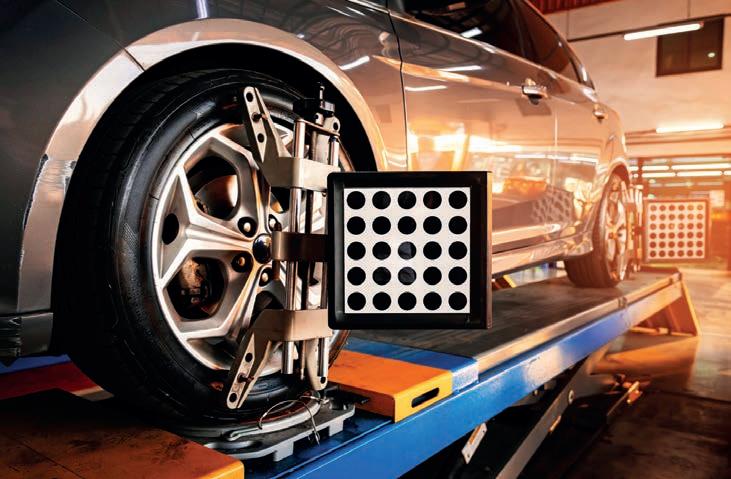
speeds, and in aggregate tends to result in accidents that are less severe. While ADAS can prevent some accidents – particularly at lower speeds – an ADAS equipped vehicle exposes more electronic components and parts to damage at higher repair costs.
Ultimately, improvements in road safety require a more holistic approach that combines technology, education, enforcement, and changes in driving behaviour. As speeds increase, the systems can only mitigate speed before impact. Until such a time that these technologies provide 100 per cent driving automation, di erences in how drivers respond to this technology will also remain a factor.
Vehicle technology costs will rise but not forever
While the US repair market has seen a sharp rise in repair costs, due to higher manufacturing costs of the technology and parts to support comfort, safety, fuel economy, the report found over time auto manufacturers were expected to see cost leveling as technologies mature and scaled. It highlighted how advancements in technology, streamlined supply chains, and lower raw material costs have helped EV manufacturers in China sharply reduce their costs and improve a ordability of their vehicles. It also cited inflation data to show the price of new technology eventually goes down even as product
improvement goes up.
The report also found new vehicle design considerations suggest automakers’ product costs will ultimately come down.
It cites as an example, the transition from an internal combustion engine (ICE) to a battery-powered electric vehicle (EV) fleet has already driven changes in vehicle design, as manufacturers look for ways to incorporate the battery into the vehicle and transition away from mechanical to electronic components.
Many EVs are built using a “skateboard” design where the battery lays at the bottom on the vehicle, with the remainder of the vehicle attached to the frame. EVs also have fewer systems and parts than ICE vehicles, meaning they should become less complex to produce, maintain, and repair over time.
Collective Solutions
The Crash report concludes that an agility in evolving and a commitment to cooperation and dialogue are the best assets of an industry in meeting these challenges across the whole automotive sector.
“Fostering relationships and dialogues between manufacturers, tech companies, insurers, and policymakers will be vital in crafting a coherent strategy that balances safety, innovation, and a ordability.”
The National Collision Repairer 43
Image: noppadon/stock.adobe.com.
ADAS systems now account for 40 per cent of vehicles in the US and calibrations are required for more than a quarter of all repair jobs.
Stateside
with John Yoswick
Changing up for success
Industry networks can be one of the strongest tools available when it comes to seeking advice and they can be doubly relevant when it comes to di cult business decisions around change.
One can’t-miss way collision shop owners can find some potentially great business ideas is to ask other shop owners about changes they’ve made recently. Understanding what prompted the changes, how they were implemented, and what the outcome has been can help inspire changes within your own shop.
Here’s a round-up of the changes some collision business operators in the United States have made in past year or two.
Scott Benavidez, a shop owner in the southwestern state of New Mexico, says he’s given his technicians in both the body and paint shop access to his estimating system so they can take and upload in-process photos.
“That has really been helping me because there’s always that one picture
you forgot to take, or the estimators have to stop what they’re doing to go back out for photos,” Benavidez says.
“Getting the technicians involved in the supplemental process has really helped streamline things. We have proof of a lot more things, we’re getting paid for a lot more things, and it speeds up the supplement a little bit.”
California shop owner Ti any Silva points to sta ng changes she’s made at her 25-employee shop that are enabling her to better “work on my business, not in it.”
She promoted an existing employee to assist the shop’s production manager and added a third person to that team in a role she’s calling repair planner.
“She’s helping with [locating] and emailing OEM repair information to the techs and making sure everybody has
everything they need to get right on that job, and helping with scheduling,” Silva says of the new hire. Despite not knowing anything about the industry, Silva says the new employee is “into technology and she can figure out anything we need.”
“She’s doing all our pre- and postrepair scanning, and arranging the calibrations done by an outside company,” Silva says.
The employee promoted to assistant production manager had worked in both the paint and body departments at various times while at the shop, “so he’s respected by the entire team,” she says.
“They are tag-teaming production, and they know they can’t both be on vacation at the same time,” Silva says.
“So, I always have a back-up person. I like to [quality control check] every

46 www.nationalcollisionrepairer.com.au
Keeping the customer informed and involved can produce the best ultimate outcome. Image: Kangwans/stockadobe.com
vehicle before it leaves my shop, but that’s not always possible. So having a production team gives us someone based behind the computer, someone out on the shop floor directing tra c, and someone who can always QC vehicles for me. It’s been working out great.”
Dropping DRPs, adding co-pays
Wisconsin shop owner Sue Black says she has eliminated some insurance company direct repair programs (DRPs) and negotiated new labour rates with some insurers.
“We have been able to work on that and really pay our technicians what they deserve to be paid so that we can retain them and also train them and keep them qualified to repair the vehicles coming to us,” Black says.
She says the shop also has started to sometimes charge customer co-pays.
“We’ve just explained to them: This is what your insurance company is willing to pay for the repair of your vehicle, but here is the research that says this is what needs to be done on your vehicle, and we want to make sure that your vehicle is getting back on the road properly, and in order to do that, you might have to pay some out-of-pocket expense,” Black says. “And because we sit down and really explain the situation to our customers, a lot of them are willing to pay extra to have their vehicle repaired the correct way.”
Personnel changes, adding transparency
Tom Ricci, a shop owner in the state Massachusetts, says he’s been pursuing more non-insurance commercial work.
“Because we’ve got a couple accounts now that we’ve groomed in the last couple of years to pay a sizably higher labour rate,” Ricci says.
Like Silva, he’s also made some management personnel changes that have been “very fruitful for morale and production.” He came to realise his production manager “wanted to play fireman, but we didn’t want fires,” so he promoted another person to that position. One of the shop’s three estimators now oversees that team and


works with the production manager.
“So that removed me a lot more from the day-to-day,” Ricci says. “But it also increased production because the two people have the right attitude as comanagers.”
Minnesota shop owner Will Latu says his company is another one that has “parted ways with several DRPs.”
“We basically made some decisions on what is our fight and what’s not our fight,” Latu says. “Keeping the consumer more involved and more updated, and peeling things back so they can see what goes on when a supplement is submitted, really lets them know how hard you’re working for them, to get them taken care of.”
The transparency helps keep customers up to date, he says.
“We give them copies of what was submitted [to the insurer], letting them know the deficiencies when it comes back, letting them know what their potential out-of-pocket could be,” Latu says. “They see we submit a repair plan that’s vastly di erent than the photo estimate the insurance company created. By the time we get down to the final bill and the gap is reduced substantially, you’re the hero. They’re happy for everything that you did throughout the repair.”
Better triaging of jobs
Andrew Batenhorst, manager of Pacific BMW Collision Center in Glendale, California, says parts delays can
be significant for BMW parts out of Germany.
“Anything that’s coming from that side of the world is four to six weeks away in some cases,” Batenhorst says.
“So, what’s been really helpful for us is being very aggressive with how we triage jobs, deciding what cars are going to come into the shop, and which ones we will keep on the road as long as possible. So, on certain job sizes, we can do a quick inspection on them, maybe loosen up the bumper or use an inspection camera to check out possible hidden damage, and we can get a repair plan that’s maybe 85 per cent to 95 per cent of the way through. We can get the parts pre-ordered and arrived, and we can cut the repair time down immensely because we’ve maybe also gone through a supplement approval at that point, too.”
He says one hurdle with this is the amount of space involved in storing more pre-ordered parts than they have in the past.
“So we’ve adapted our logistics to be able to handle it, and it’s worked really well,” he says. “We’ve had a lot of positive feedback from clients. If the car’s just cosmetically damaged, then they’re typically okay with us doing that for them. Now, if it’s not drivable, we’ll have to go ahead and get the car in. But for probably 40 per cent to 50 per cent of our work, we can minimise the downtime here, and it does pay o in the long run.”
The National Collision Repairer 47
California shop owner Ti any Silva believes in working on her business not in it.
Pacific BMW Collision Center in Glendale manager Andrew Batenhorst.
Images: John Yoswick.
Freedom of Mobility Forum suggests a slow change
The Freedom of Mobility Forum released the results of a new survey that measures the change in mobility habits of people across five countries.
According to the survey results, one in four global citizens aren’t ready to make eco-friendly transportation choices, particularly in the US where more than half of respondents in rural areas said they weren’t ready to change anything.
If the responses are an indicator of the uptake of alternative transport modes, it may mean changes to the overall car parc with elements such as shared mobility services and micro mobility, will be slower than some analysts anticipate.
The survey was in partnership with YouGov, a British market research and data analytics company.
The results were shared during the second annual Freedom of Mobility Forum. The international panel of experts and university students from three continents discussed the results, according to a news release shared by Stellantis.
According to Repairer Driven News,
while three in four individuals are gearing up for greener options less than 10 per cent have already made profound changes.
Six in ten respondents said they’re ready to ditch “driver-only” transportation, but enthusiasm varies across the map with India, Brazil, and Morocco leading the charge. Fifty per cent or less are willing to in mature markets — a factor that drops to 28 per cent in rural areas in the US where mass transit can be less available, the release states.
As for who’s steering the “green
revolution,” YouGov found it to be lawmakers and citizens with companies trailing behind. However, with exception from the United States.
Younger generations are also making more of an influence in the revolution, according to the survey results. One in four global citizens said they believe they hold the key to our green future, with 40 per cent in India believing they can spearhead change.
The survey was conducted in Brazil, France, India, Morocco, and the United States with 5,095 respondents, around 1,000 from each country.

I-CAR CEO announces retirement

The man who has overseen almost ten thousand repair shops across the globe reach new heights in industry training with Gold Class accreditation, has
decided to relinquish the reins of the organisation.
I-CAR CEO and President John Van Alstyne plans to retire at the end of 2025 after 15 years in the position, according to an I-CAR press release,
I-CAR’s chairman of the board, Jim Guthrie highlighted the Van Alstyne’s legacy at I-CAR.
“On behalf of the board, I would like to thank John for his extraordinarily positive and lasting impact on I-CAR, its customers, and its employees,” Guthrie says. “Under John’s leadership, I-CAR has gone through a period of unprecedented growth and transformation, and he has created a collaborative culture that has led to
I-CAR receiving national Top Workplace designation the past two years.”
Guthrie went on to praise Van Alstyne for a focus on talent development and the delivery of educational programming, technical information, and services to the industry.
Guthrie said Van Alstyne’s work has positioned I-CAR for continued success.
Under Van Alstyne’s leadership I-CAR reinvested US$46 million into the industry, including the opening of a new technical centre in the Chicagoland area, the release says. The centre focuses on advanced training, research, and development. The programs are aimed at improving industry-critical technician shortages.
Global News 46 www.nationalcollisionrepairer.com.au
People may be slower than expected to embrace shared transport options.
Image: chungking/stock.adobe.com.
I-CAR CEO and President, John Van Alstyne. Image: I-CAR

US company Allstate Insurance has applied for a patent of a system that can produce an augmented reality visualisation of crash scenes, according to a patent published March 5.
The technology presents a range of questions over the future of automotive insurance claims and how the added accident information technology will work with the repair industry that then works on the cars.
However, the company claims it can
Are augmented reality ‘crash scenes’ the future? Independent repair shops face information limitations
Cost and OEMs are key barriers in the “right to repair”, a recent report from the US Government Accountability O ce has found during the debate over the controversial law.
The report found that it isn’t a matter of access for independent repair shops; access exists but is either limited by OEMs or at a cost that shops say they can’t a ord.
In Australia, the right to repair became enshrined in law in 2022 after a decadelong campaign. Despite this, there are still multiple hurdles in car owners’ way when repairing their cars, including missing information and the navigation of OEM websites.
One of the Australian Automotive Service and Repair Authority’s (AASRA) key roles is to help repairers with missing information and members can
speed up the post-accident process and may also provide the repair industry with preventative information on damaged vehicles.
According to media reports the device would allow users to correspond with vehicles, real-world locations, and other objects, such as trees, the patent says. It also can include weather and the time of day.
“The accident re-creation system provides the capability to re-create the accident site on a mobile device before or soon after leaving the scene utilising augmented reality,” the patent says.
“Multiple users, such as other witnesses, other drivers, police o cers, etc. may also provide input.”
Claims processing may involve interactions with multiple insurance agents, claims adjusters, and subrogation representatives, the patent
says. The process also includes the processing of paperwork, telephone calls, and face-to-face meetings.
“As a result, a significant amount of time can elapse between the time the claim is filed and final settlement of the claim,” the patent application says.
“Therefore, a need exists for improved approaches to processing insurance claims in response to a vehicle accident.”
The patent provides multiple ways that the augmented reality scene could be created.
This includes the system receiving video of the accident site from a camera on a user’s mobile device. Users could then select objects to be displayed in the setting. Other data such as vehicle sensor information, dash cameras, and street cameras could be put into the system to recreate the reality, the patent says.
lodge a missing information report.
AASRA executive o cer Rodger Nardi told NCR on the first anniversary of the scheme it remained a “game changer” in the level of information the scheme makes available to the industry.
AASRA is responsible for assisting repairers to information, logging the requests and where applicable, helping to resolve disputes over access. Under the scheme car companies can be fined if they are found to be in breach of the law. But Nardi says the largest number of issues arise not from information being withheld but the navigation of OEM websites.
In the US where the laws are still being debated, the GAO report said, “A reduction in the ability of independent repair shops to conduct repair work could reduce consumer repair choices,
whether that reduction is due to limited access to the information, data, and tools needed for repair or to an unwillingness or inability to keep up with technological changes.”
“In addition, a disparity in access to telematics data compared to dealerships could put independent repair shops at a competitive disadvantage. These potential e ects could increase prices for consumers as well as a ect consumers in other ways.”
The report looks at how vehicle technology changes could a ect competition and consumer choice in the repair market, according to the report. Actions related to the issue by the National Highway Tra c Safety Administration (NHTSA) and Federal Trade Commission (FTC) were also reviewed, GAO said.
The National Collision Repairer 47
Image: U.S. Patent and Trademark
ce.
Allstate Insurance claims it can speed up the repair process.
O
Kia takes out New York award

In a sign of the times and the increasing market prominence of EVs, one of the first large SUVs that is battery powered has won Car of the Year.
The 2024 Kia EV9 took out both World Car of the Year and World Electric Vehicle awards at the New York Auto Show.
The judging panel is made up of 100 automotive journalists representing 29 countries who found the Kia EV9’s
innovative design, spacious seven-seat interior, and competitive price point warranted the top award.
Based on the E-GMP platform, the EV9 is the first Kia to feature fourthgeneration battery technology for improved performance.
The World Car Awards are renowned globally as a premier standard for automotive excellence and leadership, celebrating remarkable accomplishments within a rapidly changing automotive industry.
Kia has claimed three wins at the World Car Awards – the Telluride as World Car of the Year and the Soul EV as World Urban Car in 2020, along with the Kia EV6 GT taking World Performance Car of the Year in 2023.
Kia president and CEO says Ho Sung Song says the company was honoured by the win.
“This triumph is a testament to our unwavering commitment to pushing the boundaries of technology
Timeline for greater mobility for Nissan
Nissan has announced it will gradually trial autonomous-driving systems in an area of Japan where drivers are in short supply as a first step into the new era of mobility services.
As part of the company’s longterm vision, Nissan Ambition 2030, aims to solve transportation service issues faced by local communities in Japan, such as driver shortages, which are a result of an ageing population. With this service, Nissan will provide a broad range of new services that enable free movement.
It will begin with its manned services, currently in operation and then expand its autonomous driving trials.
Nissan has been testing business models for mobility services in Japan and abroad since 2017. These vicinities include the Minato Mirai area of Yokohama and Namie town, Fukushima Prefecture, where a manned mobility service called Namie Smart Mobility has been in operation since 2021.
Nissan has also been testing autonomous-drive mobility in London and other areas with the support of the UK government.
Nissan plans to begin o ering autonomous-drive mobility services in 2027, with trials beginning in the Minato Mirai area this year.
and design excellence,” he says.
“The Kia EV9’s continued success will drive us to keep delivering exceptional vehicles that redefine the driving experience for customers around the world,”
2024 Kia EV9, Kia’s first dedicated three-row EV SUV, has collected a number of prizes, including winning the ‘Family Cars’ category of the Golden Steering Wheel Awards, the 2024 North American Utility Vehicle of the Year, and ‘Best Premium SUV’ at the 2023 Newsweek Autos Awards.
“EV9 is a clear representation of Kia’s vision, and further evidence of our dedication to quality. This award cements Kia’s standing as the frontrunner in sustainable mobility solutions that go beyond conventional automobiles. We share this honour with our global teams who contributed their utmost e orts to drive EV9’s success,” said Seungkyu (Sean) Yoon, President and CEO of Kia North America and Kia America.
“During the trials, the level of autonomous driving will be gradually enhanced while assessing customer acceptance, with the aim of providing driverless services.”
In 2024 it will conduct driving tests in the Minato Mirai area of Yokohama using an autonomous driving vehicle based on the Serena minivan, aiming to expand this to a total of 20 vehicles (with a driver on board) into other areas over the next two years.
By 2027, Nissan aims to start providing services in three to four municipalities, including rural areas, with dozens of autonomous-drive vehicles.
48 www.nationalcollisionrepairer.com.au OEM News
Kia celebrates with the World Car of the Year.
Image:
Kia
Toyota claims a new champ as hybrids surge
Toyota may have only introduced its first fully electric model in Australia in March but its hybrid vehicles are showing new dominance in the marketplace.
The RAV4 topped Toyota’s sales charts in March, specially for hybrid electric variants, breaking the 5,000 sales for the first time of which 93.3 per cent or 4,728 cars were hybrid electric.
Record March volumes for RAV4 were instrumental in Toyota’s deliveries of electrified vehicles (HEV, BEV) doubling 104.7 per cent in the first quarter to 24,722 cars and SUVs compared with 12,075 vehicles in the same period last year.
According to Toyota it now has an electrified share amounting to a new high of 44 per cent for the first three
months, with the brand’s total volume accelerating by 37.4 per cent to a market-leading total of 56,238 new vehicles.
RAV4, Corolla, Camry, Kluger and Corolla Cross all had new first-quarter records for hybrid electric sales.
In March, Toyota’s sales volume of 18,961 vehicles included 9,347 electrified vehicles, representing a record share of 49.3 per cent.
Toyota Australia Vice President Sales, Marketing & Franchise Operations
Sean Hanley says the latest hybrid electric sales figures confirmed that last year’s o cial sales results reflected constraints on supply rather than the healthy underlying demand.
“Now that supply has vastly improved
Cheaper EVs could be closer for Tesla
The long-awaited prospect that leading EV manufacturer Tesla would launch a more a ordable electric car appear to have taken a back seat to its robo-taxi plans.
Tesla boss Elon Musk tweeted that the company plans to launch a new ‘robotaxi’ – an autonomous compact car without a steering wheel or pedals – on 8 August 2024,
The news in the autonomous car area, which has had its own rocky ride following accidents and safety concerns in the United States, comes after Tesla reportedly altered its plans for an inexpensive car that was hoped would further boost the company’s growth.
News agency Reuters reported that Tesla would continue developing selfdriving robotaxis on the same smallvehicle platform
In the US Tesla’s cheapest model, the Model 3 sedan, sells for about USD
$39,000 (about $59,000 AUD) and in Australia from about $62,000 AUD. In the last two years other Chinese EV manufacturers including MG and BYD have entered the market with EV models that retail for significantly less.
The entry-level vehicle consumers had been hoping for was expected, according to media reports, at around USD $25,000 or about $38,000 in Australian dollars.
According to media reports, CEO Elon Musk has promised such a vehicle to consumers and has said a planned production of the a ordable model at its Texas factory, could see them in US showrooms by 2025 or even late 2024.
This is part of the company’s longterm historical mission to produce a ordable electric cars for the mass market, manufacturing luxury models at first and using the profits from this to finance a “low-cost family car.”
for Toyota, there are clear indications of a resurgence in hybrid electric demand here in Australia and also in markets like Europe and the United States,” Mr Hanley says.
“That’s because consumers increasingly regard hybrid electric models as providing practical, capable and a ordable vehicles compared to petrol variants that help cut their carbon footprint while reducing fuel bills – and they retain strong resale values,” he said.
Mr Hanley said Toyota was particularly focused on further reducing customer wait times for popular models with many vehicles such as RAV4 hybrid electric models now averaging six months or less. The HiLux 4x4 has a four month wait and LandCruiser 300 Series, seven months.

But in the last few years Tesla has faced fierce competition from China with BYD briefly overtaking Tesla last year as the largest global manufacturer of electric vehicles.
The National Collision Repairer 49
Tesla aims to launch a robotaxi in August. Image: Moose/stock.adobe.com
with Cli Chambers
Iron fist in a velvet glove
They were stately and even subtle but these classic cars spoke of a vanished distinction while concealing some remarkable commitments to power and speed.
Some people who own fast cars want them to look the part, with stripes, aero packs and multiple exhaust outlets. Others like to blend with the tra c, leaving the car’s performance untapped until there is a need to overtake swiftly or an empty, high- speed road beckons. Germany, with its network of highspeed autobahns, has been responsible for an abundance of fast cars. Britain and the USA actively discourage travel
at 110km/h or above, yet they have for decades produced models that match the German contenders’ performance.
All apart from the big Chrysler were very expensive when new; so costly in the days before real-estate values went crazy, they would cost more than a decent suburban house. Today, the most expensive of our selected models is unlikely to top $50,000.
Savings made on the purchase price
BMW 750LI E66 SERIES

don’t help much though when talk turns to maintenance. In fact, quite the reverse.
Buying an ultra-luxury car for minimal money can saddle you with a list of overdue repair items that will dwarf the original outlay.
Wise buyers will spend somewhat more on a car that has regularly seen the inside of a specialist workshop and will, with regular attention, remain reliable.
BMW’S first V12-engined sedan, the 750iL, appeared in 1987 and was said to use more computing power to run its various systems than the Apollo 11 capsule that transported humans to the Moon. Fragile sensors and complex electronics were destined to not survive for long, and finding a viable 750iL in today’s market is almost impossible.
Luckily the later 750Li carried on the tradition of brutality in a Hugo Boss suit and has proved to be durable and seriously fast. With a 4.8-litre V8 in place of the V12 and 270kW, the 1950kg mega sedan hits 100km/h from rest in 6.4 seconds and (where legal) will reach 241km/h.
With a new shape and even greater levels of electronic complexity, the E66 sedan when new in 2006 cost $230,000 but included every luxury fitting known to exist at the time.
The problem over time is that those complex systems and gadgets, plush leather and timber veneers su er from neglectful owners and extremes of temperature.
Locally sold cars, even those that have travelled 10,000km or less annually, will typically sell at less than $30,000. Those privately imported from less hospitable countries should probably be avoided completely.
CHRYSLER 300C SRT8
lF YOU’RE looking for the mob boss or drug runner in scenes from a US telemovie, check the side-streets for a lurking 300C.
Whether by intent or pure chance, Chrysler’s decision to combine a muscular, high-waisted body with a grille echoing its 1950s ‘Letter Series’ has created a genuine American icon.
Supplementing the already tough 300C image, SRT8 versions with 317kW added some heft to this automotive broadsword and helped Hemi owners leave the scenes of various crimes more rapidly.
The SRT8 sedan at launch here in 2006 cost $71,990, with the rare Touring station wagon only $3000 more.
Accompanying the heavy-hitting engine with its five-speed autobox and Mercedes-like dogleg shift gate, this most potent of 300Cs added four-pot calipers and ventilated rotors all- round, plus 20-inch wheels with wider rubber at the back. Despite being the most powerful model in this group, with abundant leather on the inside and Bentley nuances to its styling, the SRT8 is generally cheaper than the rest.
Unless you happen to snare a car that has travelled well shy of 100,000km during its 15-20 year lifespan, the asking price for most will be $20,000 or less.

50 www.nationalcollisionrepairer.com.au Custom Corner
BENTLEY TURBO R

IF THE British aristocrats were wandering around in the late 1980s shell-shocked, partly blame this car.
For decades Bentley was a cut-price clone of Rolls-Royce and any glimmer of individuality was by accident. In the 1950s there was a swish-looking Continental R, then nothing uniquely Bentley until the 6.75lt V8 acquired a massive turbocharger, delivering boost from close to idle with maximum torque at just 1800rpm.
Australia’s first Turbo Rs in 1989, were priced at $352,000. Not only would it buy a house but one that didn’t look out of place with a Bentley in the driveway. Inside the Turbo R was good taste and luxury in abundance. The leather came from cattle raised in fields without barbed wire, minimising defects to the hides and the matched timber veneer was polished by hand. Given its opulence, Turbo R buyers may have expected the shifter protruding from the console to control a sophisticated electronic transmission. Instead, should any bother to enquire, they would find it connected to a very old-style but durable three-speed. Many Turbo Rs were sold in Australia and values a decade ago were plunging into the abyss. Only since the pandemic have they experienced a growth spurt which has pushed excellent cars towards $50,000.
MERCEDES-BENZ 450SEL 6.9
PEOPLE who moved in elite circles and wanted those movements to go almost unnoticed would often drive the most powerful of Mercedes-Benz’s 1970s products.
The original 450SEL was a popular car in Australia. Even a Prime Minister was briefly chau eured in one and car parks close to capital-city stock exchanges were brimming with the things. The SEL 6.9 was di erent.
Its engine was rated at 198kW but torque was a prodigious 510Nm. In 1978, at release, the 6.9 was claimed to be Europe’s fastest accelerating four-door sedan with a 7.2-second time for the 0-100km/h dash. The 6.9s in our used market tend to come with full histories but high kilometres. Good examples will need little spent immediately on maintenance, but save up for when that time arrives.
Air suspension played a major role in the SEL’s open-road serenity and must be kept in top condition. So too the cooling system that is vital to the health of the alloy-head engine and ensuring the air- conditioning does its job.
Values of the 450SEL 6.9 have increased during the past five years, but good cars remain a ordable. Some will be priced at $50,000 and above; money that is only viable for a car that is pristine and mechanically perfect.


highperformance saloon, it turned to supercharging.
Early versions of the XJR had 4.0-litre six-cylinder engines with a single Eaton supercharger. From 1997, with the change to V8 power, engine capacity remained at 4.0-litres but when supercharged, would produce 276kW against the six-cylinder version’s 240kW. The X300 body continued virtually unchanged in V8 guise, sitting on a 2870mm wheelbase which helped with rear-seat legroom.
The list of features was almost endless but component age and complexity meant that important systems need to be tested prepurchase. Repairs to the air-conditioning, replacement of door window motors and fixing sound-system glitches can collectively add thousands to the cost of an apparently a ordable V8. Early cars su ered piston and timing gear failures, but a ected engines will have either been replaced under warranty or had their problems cured with redesigned components. Unless a car has travelled 300,000 kilometres and is due for extensive maintenance, excellent examples might exceed $30,000. For that expect detailed service history, recent brake and suspension replacements, a decent interior and paint condition.
The National Collision Repairer 51 IMAGES: BMW/CHRYSLER/BENTLEY/MERCEDES BENZ/JAGUAR
JAGUAR dabbled with turbochargers for its Le Mans contenders and XJ220 supercar, but when reliable performance was required for a
JAGUAR XJR V8
The key use of adhesives
The use of adhesives has increased and has changed vehicle construction dramatically, improving strength and durability. Ensuring these qualities remain this way after a collision is crucial to good repairs.
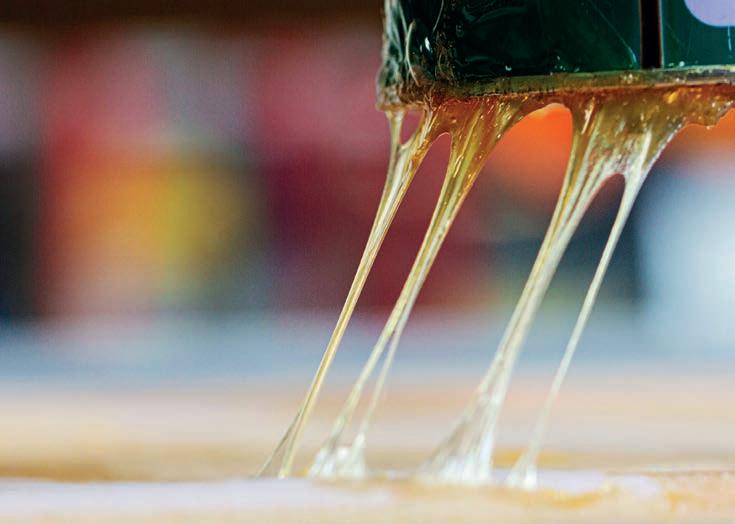
With the correct understanding and application during vehicle repair, adhesives are relatively easy to work with but there are many considerations to be taken into account to ensure that the initial bonding qualities are reproduced and the vehicle is returned to its pre-accident condition.
Ford’s current model Ranger and Everest, for instance, use weld bonding extensively throughout their construction. The use of weld bonding and rivet bonding methods on various makes and models is now common practice. The increased use of adhesives is being combined with the use of di erent types of materials such as alloys, composites, plastics, and a wide range of steels in varying strengths.
The heat sensitive nature of many of the higher strength steels is a contributing factor when OEMs introduce adhesives into the vehicle
structure. Traditional thermal joining techniques can negatively influence the various metal types during vehicle repair. Cold joining techniques used when bonding surfaces together remove high temperatures from the process ensuring the substrate is not compromised in any way, with the additional benefit of increased corrosion protection providing greater longevity and strength.
When carrying out collision repairs the use of mechanical and chemical bonding is rapidly becoming the norm rather than the exception. The most common example of mechanical bonding in collision repair is welding, but can also include nuts, bolts, clips, rivets, and screws to mention a few. Adhesives are products used to create a chemical bond. However, to ensure a repair is carried out to meet the strict strength and safety requirements designed into all Ford vehicles,
understanding how adhesives work and the pitfalls that can a ect an adhesively bonded joint is critical.
Many adhesives are now structural elements for vehicle manufacture and repair. Failure to use the correct adhesive and follow workshop manual instructions will adversely a ect the structural integrity and crash safety performance of the vehicle, which could result in serious injury to the vehicle occupants in a collision. Adhesives are developed to create a specific strength and bond to a substrate. Innocently mixing brands or types of adhesives may result in ine ective bonding. Adhesive properties are chosen with care by the engineers for very specific purposes, so it is vital that the properties required for the task are appropriate.
The following are the most common adhesives found in collision repairs:
Epoxy
Epoxy is a two-component product. One component is a reactive agent also known as an epoxide. The second component is a hardening agent. Epoxies provide a very strong bond that is resistant to moisture, chemicals, and corrosion. The product hardens when both components are mixed.
Polyurethane
Polyurethane needs moisture for it to dry. As it dries, it will usually expand making it a good product to use where high gap fill is required, and it is less brittle than other adhesives.
Acrylic
Acrylic based products can be used for several di erent construction applications. They are more prone to
52 www.nationalcollisionrepairer.com.au Tech Talk
The increased use of adhesives in automotive makes understanding their di erent applications critical.
Image: ncapro/stock.adobe.com.
cracking due to the bond being more brittle.
Single Compound
Silicon is an example of single compound adhesive but is more likely to be used as a sealant. The bond strength from silicon is usually lower than other products. Silicon provides good flexibility and some gap filling properties. It can also provide for waterproof joints.
What is an adhesive and how does it work?
An adhesive resists the separation of two surfaces which may or may not be the same material. There are many factors that a ect adhesive force including:
Absorption
Absorption is when a number of smaller forces work together like electrostatic forces. For an adhesive to work, it needs to wet the surface and spread thinly over the surface of the material.
Chemisorption
Chemisorption is when an adhesive creates a chemical bond with the material it is in contact with. An example is using a glue on certain plastics where the glue mixes with the plastic to create a new chemical compound.
Mechanical
Mechanical is when the surface of the material is porous. A porous material has lots of tiny holes that allow the glue to go into the holes. Once the glue



dries, the glue holds the material like it’s grabbing it.
Di usion
Di usion is when molecules from the material surface and glue swap molecules. This mixture of molecules holds the two items together once the glue dries.
The strength achieved when using adhesives should not be underestimated. Structural strength adhesives can reach a minimum of a 1000psi overlap shear strength with non-structural adhesives varying in strength from repositionable to strength that’s equal to or greater than the substrate being bonded and typically have less than a 1000psi overlap shear strength.
Windscreens are a key component in the structural integrity of a vehicle. They provide a significant percentage of the overall strength across the front of the vehicle structure as well as playing a vital role in the correct deployment of the passenger airbag and collision energy management. If you have ever watched ANCAP crash videos, you will clearly see the windscreen flex and bend during impact to absorb and distribute collision forces around the vehicle structure. The correct use of adhesive is vital in these scenarios.
For those still questioning the use of adhesives in vehicle production and repair, it is understandable when you consider the traditional alternative of welding which initially would seem the stronger and more suitable attachment method. However, OEMs have invested a significant amount of time into the research and testing of adhesively bonded joints and the benefits they can provide.
The correct adhesive bonding is essential to repairing the vehicle correctly. Adhesives and mechanical fasteners are used in certain areas of the body structure in place of welding. In addition to providing a structural bond between components, adhesives can also help prevent wind noise, water leaks, exhaust fumes and dust from entering the vehicle. They also provide anti-corrosion barriers.
The National Collision Repairer 53
Adhesives create structural bonds between components but also help keep out wind noise, water leaks, exhaust fumes and dust.
Some of the di erent types of testing loads used to measure adhesive performance (left)
An image of mechanical shear testing. ((right).
Common adhesive testing methods.
Images: Ford Australia.
Important considerations when using adhesives
Expiration Date
Always ensure the adhesive being used is within the expiration date. Failure to observe the expiry date can lead to significant issues with the quality and e ectiveness of the adhesive. The composition of adhesives will change over time, this will have a negative impact on the e ciency and e ectiveness of the adhesive. The use by date should never be ignored as any use after that date can a ect the strength and adhesion of the bond.
THE ONLY JUMP STARTER THAT CHARGES ITSELF.
Temperature
From storage to application and curing, temperature is one of the most important considerations when using adhesives. Storing adhesive outside of the recommended temperature range will permanently damage the adhesive by negatively a ecting the molecular structure. Once damaged, the adhesive may still appear to be ready to use, but due to the molecules being altered, it will not perform in the same way as expected.
Preparation
Preparation is another area where temperature should be carefully considered. Many OEMs stress that all vehicle components, the adhesive, and the ambient temperature are all within the recommended processing
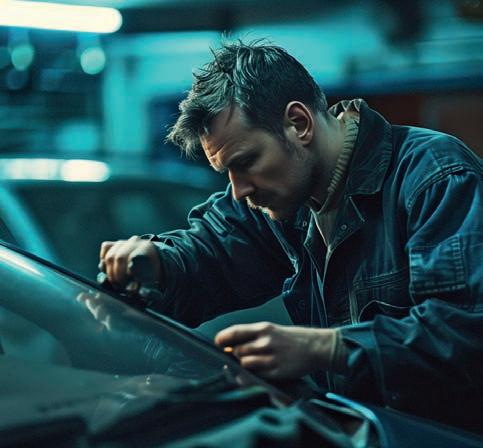
temperature range for a certain period of time, normally 20-30 minutes before beginning the bonding process. This is to ensure that any risk of moisture between the adhesive and the substrate is removed. If the adhesive is warmed to room temperature (20 degrees Celsius) then applied to a surface that is significantly cooler, moisture will form between the materials as the warm and cold surfaces come together. This will not be immediately noticeable, but the long-term damage this can lead to can be severe, with corrosion and surface separation becoming a very serious reality.
Surface Preparation
Featuring Projecta’s patented Rapid Recharge Technology, Intelli-Start Lithium Jump Starters recharge themselves in 40 seconds once a vehicle is started, elimiating the need for
Adhesives are incredibly strong but rely heavily on the correct surface preparation. Without the correct preparation, the adhesive can become totally ine ective and separate under even the smallest of load pressures. It is important to read the information to determine how the surface should be prepared. Some adhesives can be applied directly to the manufacturer e-coat, while others must be applied directly to the material surface. Primers can be required for certain adhesives, and understanding how to apply these correctly is vitally important. If abrasives are required to prepare the surface, ensure not only the correct grit size is used, but also the correct type of abrasive. If the adhesive is being used with aluminium, the abrasive must be rated for that material. Using a standard abrasive belt or disc can contaminate the material surface leading to a weakened bond.
They’re compact, lightweight, ultra-safe, and provide up to 4 times the lifecycle of Lithium Cobalt alternatives, making them perfect for workshops, roadside assistance and fleet vehicles.
Mixing and Application
Always follow the application instructions by the vehicle OEM and the adhesive manufacturer which is critically important when using two-part products for correct mixing ratios. The correct mixing nozzle that is supplied with the adhesive should always be used and never replaced with an alternative. The nozzles may appear the same, but the augers within can be significantly di erent, varying is number and size. These are developed
to ensure they provide the correct mixing ratio for the adhesive they are supplied with. Replacing them can lead to incorrect mixing and curing.
Two beads should always be squeezed from the tube prior to use. Firstly, a mixing bead the length of the nozzle and then a second test bead with supporting information, such as temperature, use by date etc which can be kept as a reference and verification.
Attachment
Once the panel is placed into position on the vehicle, the various anchoring methods must then be applied to work in conjunction with the adhesive. Rivets and weld bonding being some of the most common.
Whenever thermal joining is required in conjunction with adhesives, careful consideration of the heat input must be taken. Excessive or prolonged heat input can seriously a ect the adhesive, causing weakness and potential corrosion issues.
Health and Safety should always be considered during any type of vehicle repair, but with the increasing use of adhesives, awareness of the health risks becomes paramount. Weld bonding is commonly required by a number of OEMs, but failure to follow OH&S guidelines can place the technician at increased risk of longterm health problems. When heat is applied directly through the adhesive, it will burn and emit smoke and gases into the atmosphere. These emissions can be very harmful when inhaled, with carcinogens and toxins being released. Using fume extraction and additional breathing protection should always be standard practice.
NB This article is for information purposes only and is general in nature. For more detailed instructions on the use of adhesives in collision repairs, repair procedures are available from Ford in vehicle-specific Service Manuals, Body Repair Manuals, Technical Service Bulletins and Instruction Sheets
This article was contributed by Ford Australia.


PROJECTA INTELLI-START
projecta.com.au ASK AN AUSSIE POWER EXPERT ON
54 www.nationalcollisionrepairer.com.au Tech Talk
Care is needed in any repair using adhesives to ensure the vehicle retains its strength and durability.
Image; Denis Tuev/stock.adobe.com.

The National Collision Repairer Symposium will provide an opportunity to discuss key issues facing the collision repair industry, and how we can address these to ensure industry longevity and success. Sponsorship provides a unique chance to position your business as a leader in this sector and connect with decision makers.




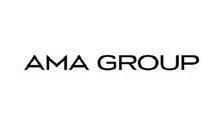
GET TICKETS
SYDNEY 19 JUNE 2024 Platinum
Symposium sponsors www.ncrsymposium.com.au
TICKETS ON SALE NOW
sponsor













































































































































